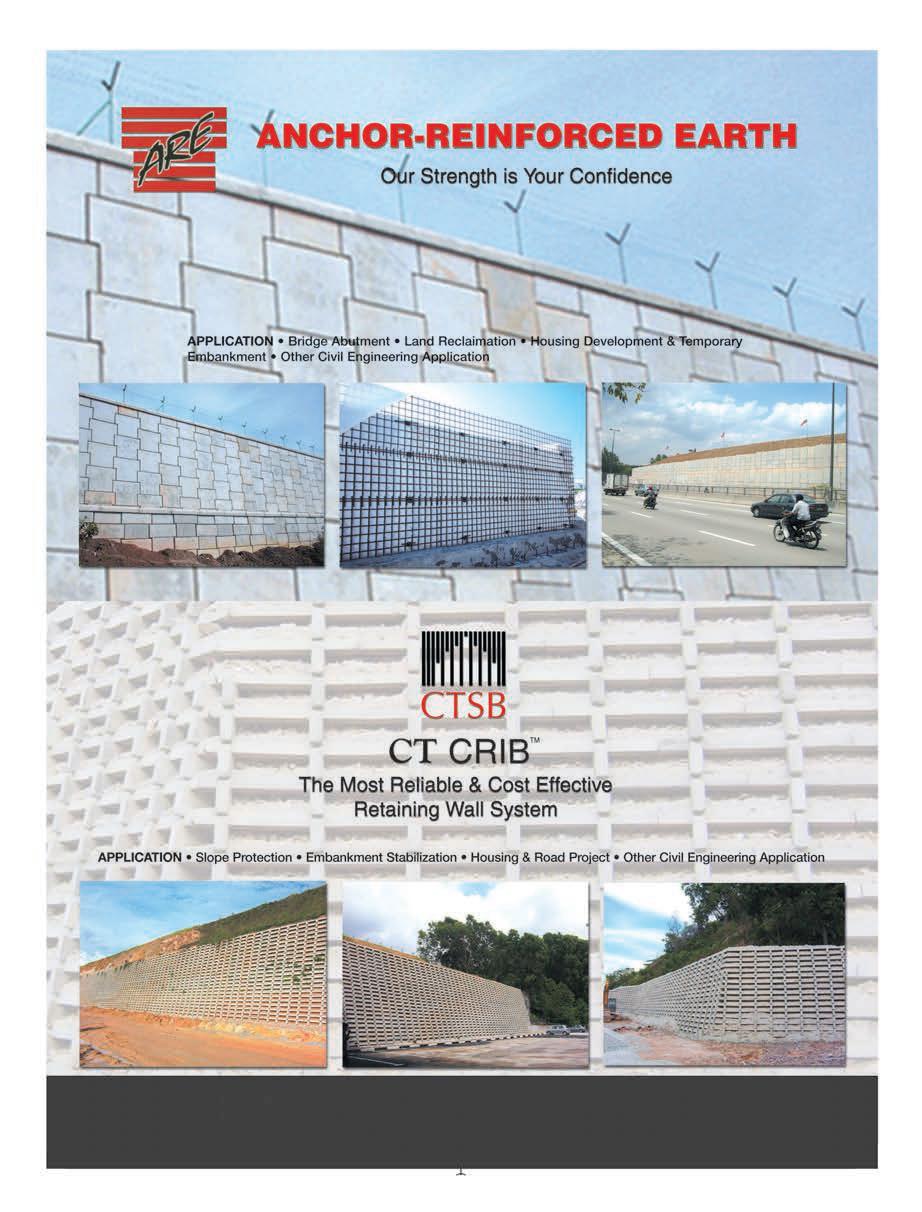







JURUTERA has an estimated readership of 168,000 professionals. Our esteemed readership consists of certified engineers, decision making corporate leaders, CEOs, government officials, project directors, entrepreneurs, project consultants, engineering consulting firms and companies involved with engineering products and services.
Our business partners can be assured that their products and services will be given the circulation and exposure it deserves, thus maintaining a sustained advertising presence to our core readers of decision-making engineers and technical experts. Our website offers an even wider market reach, with added international presence, aided by our international affiliation with official engineering bodies all over the world. Our online and offline advertising features such as banner advertising, article sponsorship and direct e-mail announcements have proven to be successful marketing strategies that will set the businesses of our partners apart from their competition.
For advertising enquiries, please contact:










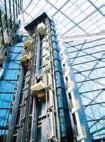




The Bailonggang WWTP is recognized as the largest plant of its type in Asia. This plant, located in Shanghai’s southern suburbs close to the estuary of the Yangtze River, began operating in 1999. In 2008 it was upgraded and expanded, and a further expansion in 2012 increased the plant’s capacity to 740 million gallons or 3.36 billion litres per day. The facility now processes more than half of the wastewater from Shanghai, China’s most populous city.
After a comprehensive survey of many options, Xypex was selected by the construction project group to waterproof, protect and enhance the durability of the eight Anaerobic Sludge Digesters, a Sludge Drying and Disposal Facility and Disposal Facility. All internal concrete faces of the eight digesters were treated with Xypex Concentrate. In areas where anaerobic activity and a highly aggressive chemical environment were anticipated, an acid-resistant lining was applied. However, the designers specified that Xypex also be applied to these specific areas as well, not only to provide secondary protection for the concrete but also to enhance the performance and durability of the primary acid-resistant lining.
For more information on how our solutions can provide sustainable benefits for your concrete assets, please visit our website at www.xypex.com.au or LinkedIn Page.
Tel: +603-51928186 Fax: +603-51926826


Number 01, JANUARY 2018 IEM Registered on 1 May 1959
MAJLIS BAGI SESI 2017/2018 (IEM COUNCIL SESSION 2017/2018)
YANG DIPERTUA / PRESIDENT
Ir. Dr Tan Yean Chin
TIMBALAN YANG DIPERTUA / DEPUTY PRESIDENT
Ir. David Lai Kong Phooi
NAIB YANG DIPERTUA / VICE PRESIDENTS
Ir. Prof. Dr Jeffrey Chiang Choong Luin, Ir. Prof. Dr Norlida bt Buniyamin, Ir. Ellias Bin Saidin, Ir. Prof. Dr Ruslan bin Hassan, Ir. Lai Sze Ching, Ir. Lee Boon Chong, Ir. Ong Ching Loon
SETIAUSAHA KEHORMAT / HONORARY SECRETARY
Ir. Yap Soon Hoe
BENDAHARI KEHORMAT / HONORARY TREASURER
Ir. Dr Wang Hong Kok
BEKAS YANG DIPERTUA TERAKHIR / IMMEDIATE PAST PRESIDENT
Y.Bhg. Dato’ Ir. Lim Chow Hock
BEKAS YANG DIPERTUA / PAST PRESIDENTS
Y.Bhg. Academician Tan Sri Dato’ Ir. (Dr) Hj. Ahmad Zaidee bin Laidin, Y.Bhg. Dato’ Ir. Dr
Gue See Sew, Y.Bhg. Dato’ Paduka Ir. Keizrul bin Abdullah, Y.Bhg. Academician Dato’ Ir.
Prof. Dr Chuah Hean Teik, Mr. Choo Kok Beng
WAKIL AWAM / CIVIL REPRESENTATIVE
Ir. Dr Lee Yun Fook
WAKIL MEKANIKAL / MECHANICAL REPRESENTATIVE
Ir. Fam Yew Hin
WAKIL ELEKTRIK / ELECTRICAL REPRESENTATIVE
Ir. Lim Kim Ten
WAKIL STRUKTUR / STRUCTURAL REPRESENTATIVE
Ir. Dr Ng Soon Ching
WAKIL KIMIA / CHEMICAL REPRESENTATIVE
Ir. Prof. Dr Thomas Choong Shean Yaw
WAKIL LAIN-LAIN DISPLIN / REPRESENTATIVE TO OTHER DISCIPLINES
Ir. Roznan bin Abdul Rashid
WAKIL MULTIMEDIA DAN ICT / ICT AND MULTIMEDIA REPRESENTATIVE
Ir. Dr Chuah Joon Huang
AHLI MAJLIS / COUNCIL MEMBERS
Ir. Mohd Khir bin Muhammad, Y.Bhg. Dato’ Ir. Hj. Hanapi Bin Mohammad Noor, Ir. Dr Ahmad Anuar bin Othman, Ir. Ishak bin Abdul Rahman, Ir. Chong Pick Eng (PE Chong), Ir. Ng Yong Kong, Ir. Tejinder Singh, Ir. Sreedaran a/l Raman, Ir. Roger Wong Chin Weng, Ir. Assoc. Prof. Dr Ahmad Kamil bin Arshad, Ir. Dr Tan Kuang Leong, Ir. Hoo Choon Sean, Y.Bhg. Lt. Jen. Dato’ Wira Ir. Ismail bin Samion (Ret. RMAF), Y.Bhg. Dato’ Ir. Hj. Anuar bin Yahya, Ir. Mah Way Sheng, Ir. Gunasagaran a/l Kristnan, Ir. Chen Harn Shean, Ir. Mohd Aman bin Hj. Idris, Ir. Gopal Narian Kutty, Ir. Dr Jimmy Mok
Vee Hoong, Ir. Assoc. Prof. Dr Leong Wai Yie, Ir. Razmahwata Mohamad Razalli, Ir. Abdul Razak Yakob, Ir. Yau Chau Fong, Y.Bhg. Dato’ Ir. Foong Choy Chye, Y.Bhg. Dato’ Ir. Kisai bin Rahmat, Ir. Yam Teong Sian, Y. Bhg. Dato’ Ir. Low Keng Kok, Y. Bhg. Dato’ Ir. Hj. Abdul Rashid bin Maidin
PENGERUSI CAWANGAN / BRANCH CHAIRMAN
1. Pulau Pinang: Ir. Ting Chek Choon
2. Selatan: Ir. Mohd Khir Muhammad
3. Perak: Ir. Abdul Razak bin Ali
4. Kedah-Perlis: Ir. Prof. Dr Rezuwan bin Kamaruddin
5. Negeri Sembilan: Y. Bhg. Dato’ Ir. Zainurin bin Karman
6. Kelantan: Ir. Hj. Mohd Zaim bin Abd. Hamid
7. Terengganu: Ir. Atemin bin Sulong
8. Melaka: Ir. Dr Tan Chee Fai
9. Sarawak: Ir. Vincent Tang Chok Khing
10. Sabah: Ir. Dr James Yong Hon Min
11. Miri: Ir. Paul Chiew Lik Ing
12. Pahang: Y. Bhg. Dato’ Ir. Sharuddin bin Mohd Simin
AHLI JAWATANKUASA INFORMASI DAN PENERBITAN / STANDING COMMITTEE ON INFORMATION AND PUBLICATIONS 2017/2018
Pengerusi/Chairman: Ir. Prof. Dr Ruslan Hassan Naib Pengerusi/Vice Chairman: Ir. Mohd. Khir Muhammad Setiausaha/Secretary: Ir. Lau Tai Onn
Ketua Pengarang/Chief Editor: Ir. Prof. Dr Ruslan Hassan Pengarang Buletin/Bulletin Editor: Ir. Mohd. Khir Muhammad Pengarang Prinsipal Jurnal/Principal Journal Editor: Ir. Prof. Dr Ruslan Hassan Pengerusi Perpustakaan/Library Chairman: Ir. C.M.M. Aboobucker Ahli-Ahli/Committee Members: Ir. Ong Guan Hock, Ir. Yee Thien Seng, Ir. CMM Aboobucker, Ir. Chin Mee Poon, Ir. Dr Oh Seong Por, Ms. Michelle Lau Chui Chui, Ir. Abdul Razak bin Yakob, Ir. Prof. Dr Abdul Aziz bin Abdul Samad
LEMBAGA PENGARANG/EDITORIAL BOARD 2017/2018
Ketua Pengarang/Chief Editor: Ir. Prof. Dr Ruslan Hassan Pengarang Buletin/Bulletin Editor: Ir. Mohd. Khir Muhammad Pengarang Jurnal/Journal Editor: Ir. Prof. Dr Ruslan Hassan Ahli-ahli/Committee Members: Ir. Lau Tai Onn, Ir. Ong Guan Hock, Ir. Yee Thien Seng, Ms. Michelle Lau Chui Chui, Ir. Dr Oh Seong Por Secretariats: Janet Lim, May Lee
THE INSTITUTION OF ENGINEERS, MALAYSIA
Bangunan Ingenieur, Lots 60 & 62, Jalan 52/4, P.O. Box 223, (Jalan Sultan), 46720 Petaling Jaya, Selangor Darul Ehsan.
Tel: 603-7968 4001/4002 Fax: 603-7957 7678 E-mail: sec@iem.org.my Homepage: http://www.myiem.org.my

COVER NOTE Geosynthetics 5
6 - 12
COVER STORY
Geosynthetics Come of Age in Malaysia
13 - 33
FEATURE ARTICLES
Concept of Centrifuge Modelling for Geotechnical Studies ...........................................13
Geosynthetics Engineering ..................................19
Comparison of Friction Angle Measured in Square and Circular Direct Shearbox Tests .........23
34 - 37
FORUMS
One-Day Seminar on Response of Buildings to Excavation-Induced Movements .........................34
Technical Talk on Mechanistic-Empirical Pavement Design with Hexagonal Geogrids ......37
ENGINEER’S LENS Victoria Bridge
ENGINEER’S ADVENTURES
Clifton Bridge and I.K. Brunel
PINK PAGE
Interview 43 - 44
45 - 48
BLUE PAGE
Membership List
Publisher:
Explore our full set of Professional and Integrated PUBLISHING MANAGEMENT SERVICES:
» Project Management
» Creative Management
» Ad Space Management
» Mailing Management
» Print Management
• Annual Reports
• Booklets • Brochures
• Buntings • Business Cards
• CD / DVD Replications
• Calendars • Cards & Invitations
• Certificates • Custom Printings
• Envelopes • Folders
• NCR Bill Books • Notepads
• Leaflets • Letterheads
• Paper Bags • Posters
• Stickers • Others




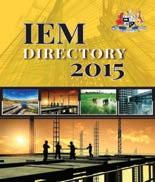
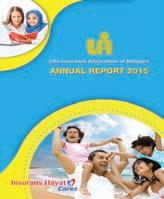



































Dimension Publishing Sdn Bhd (449732-T) Level 18-01-03, PJX-HM Shah Tower, No. 16A, Persiaran Barat, 46050 Petaling Jaya, Selangor Darul Ehsan, Malaysia. Tel: +603 7493 1049 Fax: +603 7493 1047 E-mail: info@dimensionpublishing.com Shirley Tham : +6016 283 3013Joseph How : +6011 1234 8181
DIMENSION PUBLISHING SDN. BHD. (449732-T)
Level 18-01-03, PJX-HM Shah Tower, No. 16A, Persiaran Barat, 46050 Petaling Jaya, Selangor Darul Ehsan, Malaysia. Tel: +(603) 7493 1049 Fax: +(603) 7493 1047
E-mail: info@dimensionpublishing.com Website: www.dimensionpublishing.com
Chairman
ROBERT MEBRUER
CEO/Publisher
PATRICK LEUNG
General Manager
SHIRLEY THAM shirley@dimensionpublishing.com
Head of Marketing & Business Development
JOSEPH HOW joseph@dimensionpublishing.com
Editor
TAN BEE HONG bee@dimensionpublishing.com
Contributing Writers
PUTRI ZANINA & ZOE PHOON putri@dimensionpublishing.com zoe@dimensionpublishing.com
Senior Graphic Designer
SUMATHI MANOKARAN sumathi@dimensionpublishing.com
Graphic Designer
NABEELA AHMAD beela@dimensionpublishing.com
Advertising Consultants
THAM CHOON KIT ckit@dimensionpublishing.com
Accounts cum Admin Executive
YEN YIN yenyin@dimensionpublishing.com
For advertisement placements and subscriptions, please contact:
DIMENSION PUBLISHING SDN. BHD. (449732-T)
Level 18-01-03, PJX-HM Shah Tower, No.16A, Persiaran Barat, 46050 Petaling Jaya, Selangor Darul Ehsan, Malaysia. Tel: +(603) 7493 1049 Fax: +(603) 7493 1047
E-mail: info@dimensionpublishing.com
Subscription Department
E-mail: info@dimensionpublishing.com
Printed by
HOFFSET PRINTING SDN. BHD. (667106-V) No. 1, Jalan TPK 1/6, Taman Perindustrian Kinrara, 47180 Puchong, Selangor Darul Ehsan, Malaysia. Mailer
PERFECT MAIL SERVICES (648839-P) 14 Jalan TSB 2, Taman Perindustrian Sungai Buloh, Sungai Buloh, Selangor Darul Ehsan, Malaysia. Tel: +(603) 6156 5288
JURUTERA MONTHLY CIRCULATION : 22,500 COPIES
Submission or placement of articles in JURUTERA could be made to the:Chief Editor
THE INSTITUTION OF ENGINEERS, MALAYSIA (IEM) Bangunan Ingenieur, Lots 60 & 62, Jalan 52/4, P.O. Box 223 (Jalan Sultan), 46720 Petaling Jaya, Selangor. Tel: +(603) 7968 4001/4002 Fax: +(603) 7957 7678 E-mail: pub@iem.org.my or sec@iem.org.my IEM Website: http://www.myiem.org.my
© 2018, The Institution of Engineers, Malaysia (IEM) and Dimension Publishing Sdn. Bhd.
PUBLICATION DISCLAIMER
The publication has been compiled by both IEM and Dimension with great care and they disclaim any duty to investigate any products, process, services, designs and the like which may be described in this publication. The appearance of any information in this publication does not necessarily constitute endorsement by IEM and Dimension. There is no guarantee that the information in this publication is free from errors. IEM and Dimension do not necessarily agree with the statement or the opinion expresssed in this publication.
COPYRIGHT
JURUTERA Bulletin of IEM is the official magazine of The Institution of Engineers, Malaysia (IEM) and is published by Dimension Publishing Sdn. Bhd. The Institution and the Publisher retain the copyright over all materials published in the magazine.
of
part of this magazine

by Ir. Lee Peir Tien Chairman, Geotechnical Engineering Technical Division
n general, soil is inherently weak in tension and some types, especially soft clay, have low shear strength and low permeability. In the past, engineers would use natural materials to improve the soil/ground. For example, using bamboo allows an embankment to be built on soft ground.
But, with new technology, geosynthetics are now commonly used in the construction industry to improve the soil/ground and thus allow construction works to be carried out effectively (cost & time), practically and in an environmentally-friendly manner. For example, Prefabricated Vertical Drain (PVD) is being used widely in the place of sand drain due to its cost effectiveness and fast installation.
Geosynthetics are used extensively in the construction industry, especially in geotechnical engineering applications, to provide technical practicality and cost effective solutions. But although relevant standards and handbooks are available, engineers often face difficulties in specifying the appropriate and adequate technical requirements of geosynthetics products. Other than that, correct testing methods are also important to ensure the selected geosynthetics products will perform as per design intention. A proper understanding of the behaviour, advantages, disadvantages etc. of each type of product is vital in the selection process. As such, The Institution of Engineers, Malaysia looks forward to working with the Malaysian Chapter of International Geosynthetics Society (MyIGS) to equip our engineers with the proper knowledge and to safeguard public interest.


Ir. Dr Ooi Teik Aun, a civil engineer with postgraduate training in geotechnical engineering since the 1960s, has seen significant progress and development in the field over the last five decades.
"When I first started my professional training in 1968, the scale of projects was small; buildings were not higher than 20 stories and retaining walls not more than five metres in height," he said.
“Today, we have 118-storey buildings with six basements, 80m-deep TBM twin tunnel borings under buildings and cable-stayed long-span bridges are the norm. It's a changed and different scenario, where structures not only need to withstand the natural elements but also acts of terrorism.”

IProfessor Dr Fauziah Ahmad lectures on geotechnical engineering at Universiti Sains Malaysia. She is also the President of International Geosynthetics Society (Malaysia Chapter) or MyIGS. She has been a civil engineer since 1983.
n 1977, when Paris hosted the first International Conference on The Use of Fabrics In Geotechnics, the terms geotextile and geomembrane were introduced to an audience captivated by the fast-developing field of geosynthetics.
The conference served to connect manufacturers, researchers and consumers eager to explore and learn more about these still-new materials and all aspects of their potential.
Today, geosynthetics are used in every aspect of civil and some environmental engineering – as reinforcement, filter and separation layer – enabling the construction of challenging projects while protecting the environment at the same time.
In this issue of JURUTERA, Ir. Dr Ooi Teik Aun and Professor Dr Fauziah Ahmad explain more about geosynthetics.
Prof. Fauziah: Geosynthetics are synthetic products of which at least one component is a synthetic or natural polymer in the form of a sheet, a strip or a three-dimensional structure. They can be non-woven, knitted or woven and used in contact with soil/rock and/or other materials in geotechnical and civil engineering applications. These include planar structures (geomembranes, geotextiles, geosynthetic barriers, geonets, geogrids, geostrips, geospacers and geomats, etc.) and three-dimensional structures (geocells, geofoams, gabions and concretefilled mattresses).
Dr Ooi: To add on, the polymeric nature of the products makes them suitable for use in the ground where high levels of durability are required. They can also be used in exposed applications.
Geosynthetics are available in various forms and materials. These products have a wide range of applications and are currently used in many civil, geotechnical, transportation, geoenvironmental, hydraullic and private development applications including roads, airfields, railroads, embankments, retaining structures, reservoirs, canals, dams, erosion control, sediment control, landfill liners and covers, mining, aquaculture and agriculture.
Can geosynthetics be categorised into certain groups or families?
Dr Ooi: Geosynthetics can be broadly classified into categories based on method of manufacture. The eight main categories are geotextiles, geogrids and geonets, geomembranes, geosynthetic clay liners (GCL), geofoam, geocells, geocomposites and geopipes.
1. Geotextiles are continuous sheets of woven, nonwoven, knitted or stitch-bonded fibres or yarns. The sheets are flexible and permeable and generally have the appearance of fabric. Geotextiles are used for separation, filtration, drainage, reinforcement and erosion control applications.
2. Geogrids are geosynthetic materials which have an open grid-like appearance. The principal application for geogrids is the reinforcement of soil. Geonets are open grid-like materials formed by two sets of coarse, parallel, extruded polymeric strands intersecting at a constant acute angle. The network forms a sheet with in-plane porosity that is used to carry relatively large fluid or gas flows.
3. Geomembranes are continuous flexible sheets manufactured from one or more synthetic materials. They are relatively impermeable and are used as liners for fluid or gas containment and as vapour barriers.
4. Geosynthetic Clay Liners (GCLs) are geocomposites prefabricated with a bentonite clay layer typically incorporated between a top and bottom geotextile layer or geotextile bentonite bonded to a geomembrane or single layer of geotextile. Geotextile-encased GCLs are
often stitched or needle-punched through the bentonite core to increase internal shear resistance. When hydrated, they are effective as a barrier for liquid or gas and are commonly used in landfill liner applications, often in conjunction with a geomembrane.
5. Geofoam blocks or slabs are created by the expansion of polystyrene foam to form a low-density network of closed, gas-filled cells. Geofoam is used for thermal insulation as a lightweight fill or as a compressible vertical layer to reduce earth pressures against rigid walls.
6. Geocells are relatively thick, three-dimensional networks constructed from strips of polymeric sheet. The strips are joined together to form interconnected cells in-filled with soil or, sometimes, concrete. In some cases, 0.5m to 1m wide strips of polyolefin geogrids are linked together with vertical polymeric rods to form deep geocell layers called geomattresses.
7. Geocomposites are geosynthetics made from a combination of two or more geosynthetic types. Examples include geotextile-geonet, geotextilegeogrid and geonet-geomembrane. Prefabricated geocomposite drains or prefabricated vertical drains are formed by a plastic drainage core surrounded by a geotextile filter.
8. Geopipes are perforated or solid-wall polymeric pipes used for drainage of liquids or gas (including leachate or gas collection in landfill applications). In some cases the perforated pipe is wrapped with a geotextile filter.
What are the most commonly-used families of geosynthetics in Malaysia? Where are they usually utilised?
Prof. Fauziah: In Malaysia, which has seen much development in many areas of construction, some of the more popular applications include:
• Roads and pavements: Subgrade Separation and Stabilisation, Base Reinforcement, Overlay Stress Absorption and Reinforcement.
• Subsurface drainage: Subgrade Dewatering, Road Base Drainage, Structure Drainage.
• Erosion and Sediment Control: Hard Armor Systems, Silt Fence.
• Reinforced Soil Systems: Embankments Over Soft Foundations, Reinforced Steepened Slopes, Reinforced Soil Walls.
• Seepage Control Systems: Structure Water Proofing, Environmental Protection.
Dr Ooi: From my experience, commonly-used families of geosynthetics in the country include geotextiles, prefabricated vertical drain and geogrid (going by the amount of reinforced soil slopes and walls nationwide). Along with geogrids, geomembranes and geocells, these are utilised because they are manufactured to be lightweight, yet possess tensile strength and are inert, green and sustainable as well.
Based on their main functions, why would we want to use geosynthetics?
Dr Ooi: Geosynthetics have tensile strength with a consistent quality that can be subjected to control. They are sustainable and green in their application and are used for functions such as separation, filtration, drainage, reinforcement, fluid/gas containment and erosion control. In some cases, geosynthetics may serve dual functions.
In the case of separation, geosynthetics act to separate two layers of soils with different particle size distribution. For example, geotextiles are used to prevent road base materials from penetrating the underlying soft subgrade soils, thus maintaining design thickness and roadway integrity. Separators also help to prevent fine-grained subgrade soils from being pumped into permeable granular road bases.
For filtration, geosynthetics act like a sand filter by allowing water to move through the soil while retaining all upstream soil particles. For example, geotextiles are used to prevent soils from migrating into drainage aggregate or pipes while maintaining the flow through the system. Geotextiles are also used below rip rap and other armour materials in coastal and river bank protection systems to prevent soil erosion.
In the case of drainage, geosynthetics act as a drain to carry fluid flows through less permeable soils. For example, geotextiles are used together with granular fill to dissipate pore water pressures at the base of roadway embankments. For higher flows, geocomposite drains have been developed. These materials are used as pavement edge drains, slope interceptor drains as well as abutment and retaining wall drains. Prefabricated Vertical Drains (PVDs) have been used to accelerate consolidation of soft cohesive foundation soils below embankments and preload fills.
For reinforcement, geosynthetics act as a reinforcement element within a soil mass or in combination with the soil to produce a composite with improved strength and deformation properties over the unreinforced soil. For example, geotextiles and geogrids are used to add tensile strength to a soil mass in order to create vertical or near-vertical changes in grade (reinforced soil walls). Reinforcement enables embankments to be constructed on very soft foundations and to build embankment side slopes at steeper angles than would be possible otherwise. Geosynthetics (usually geogrids) have also been used to bridge over voids that may develop below load bearing granular layers (roads and railways) or below cover systems in landfill applications.
In the case of fluid/gas (barrier) containment, the geosynthetic acts as a relatively impermeable barrier to fluids or gases. For example, geomembranes, thin film geotextile composites, geosynthetic clay liners (GCLs) and field-coated geotextiles are used as fluid barriers to impede flow of liquid or gas. This function is also used in asphalt pavement overlays, encapsulation of swelling soils and waste containment.
For erosion control, geosynthetics act to reduce soil erosion caused by rainfall impact and surface water runoff. For example, temporary geosynthetic blankets and permanent lightweight geosynthetic mats are placed over exposed soil surface on slopes. Geotextile silt fences are used to remove suspended particles from sediment-laden runoff water.
Geotextiles are also used in other applications. For example, they are used as cushion layers to prevent puncture of geomembranes (by reducing point contact stresses) from stones in the adjacent soil, waste or drainage aggregate during installation and while in service. Geotextiles are used as daily covers to prevent dispersal of loose waste by wind or birds at the working surface of municipal solid waste landfills. Geotextiles have also been used for flexible concrete formworks and for sandbags. Cylindrical geotubes are manufactured from double layers of geotextiles which are filled with hydraulic fill to create shoreline embankments or to dewater sludge.
Prof. Fauziah: Based on the functions of geosynthetics as mentioned by Dr Ooi, when properly applied in projects, using the right design-by-function method can lead to advantages such as:
• Commonly-accepted as durable, long-lasting and environmentally-safe solutions to geotechnical engineering projects.
• Savings of 30% in total project costs.
• Directly minimising regular repair and maintenance costs.
• Preventing accidents, increasing the efficiency of structures, minimising pollution and leading to efficient use of natural resources.
Can you share some historical applications of geosynthetics and some of the early projects?
Dr Ooi: The idea to reinforce soil is not new to human civilisation. For instance, split-log corduroy roads over peat bogs date back to 3,000 BC. Other examples are the construction of Ziggurats of Mesopotamia (built using clay bricks reinforced with woven mats of reed laid horizontally on a layer of sand and gravel at certain vertical spacing) and Great Wall of China (built with clay or pounded earth reinforced with tree branches).
In Malaysia, geotextiles were the first materials to be used in the 1970s for soft ground and ex-mining land such as Kampung Pandan, soil reinforcement and in prefabricated vertical drains as filter material for ground improvements.
In 1985, geogrid products were first used by Professor F.K. Chin for the Jitra-Butterworth highway as basal reinforcement of soil embankment in soft ground.
He also used geogrids in the rehabilitation of the Petronas bungalow slope failure in Fraser’s Hill in 1987. In this case, geogrid was used as soil-reinforced slope. It was also used as soil reinforcement in the repair of the Motel Desa slope failure in Terengganu in 1985 and to repair the Temerloh-Mentakab highway embankment failure with a soil reinforced slope that same year so as to build a steeper slope within the road reserve.

ROOFING
FLOORING & COATING
SEALING & BONDING
TILING SYSTEMS
WATERPROOFING
REPAIR & PROTECTION
You may know us for just one skill area, but Sika has over 100 years of global experience in providing durable and high performance solutions for the key areas of construction.
Sustainability is a key component of the company’s innovation drive; Sika aims to enhance durability and improve both energy and material efficiency for buildings as well as for industrial applications.
Sika’s local Specification team can provide a tailored solution to your project requirements. They offer specification support and complete system details, as well as advice on life-cycle optimisation.
STRENGTHENING CONCRETE

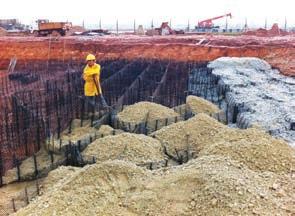

The use of geogrid in pavement design started with the Sungei Way Quarry Trial, in 1985 as well. Geogrids were also used in the world-renowned Muar Flats Embankment programme in 1987. Full-scale testing of the hexagonal/ triangular shape geogrids (TriAx) was carried out at the Q-Cell site in the Selangor Science Park in 2008/09, prior to the actual design and construction of TriAx geogrids at the site.
All these works were described in the state-of-the-art paper by Ooi & Tee, published in the SEAGS-AGSSEA Journal in March, 2011. The paper also covered many recent major slope repair works, including that at the massive landslide in Kampung Pasir in 2006.
Geosynthetics have emerged as exciting engineering materials with a wide range of applications. The rapidity at which the related products are being developed and used, is nothing short of amazing. What do you think are the reasons for the explosion of geosynthetic products?
Prof. Fauziah: Some of the reasons why geosynthetics are accepted widely by the construction industry are:
• They are quality-control manufactured in a factory environment.
• They can be installed rapidly.

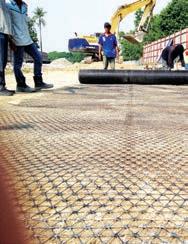
• They generally replace difficult designs that use soil or other construction materials.
• They are generally cost competitive when compared to soils or other construction materials. For instance, reinforcing a soil wall using geosynthetics can provide savings of 20%-50% from the conventional reinforced concrete wall.
• They allow for the reduction of carbon footprint.
• In some cases, they make heretofore impossible designs and applications possible.
• Their technical database (both design and testing) is reasonably established.
• They are being integrated into the industry via generic specifications.
• They are being actively marketed and are widely available.
What are the more interesting, challenging or important projects using geosynthetics that you have completed?
Dr Ooi: Some aspects of ground improvement works for the new Deep Water Port in Kampung Senari, Sarawak. Also the proceedings conference on Recent Advances in Soft Soil Engineering in Kuching, Sarawak.
Prof. Fauziah: I have not designed or been involved in any

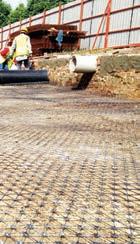


big project but rather, I am conducting research related to reinforced earth using innovative material. My peers and fellow committee members have solved many slopeprotection issues in the Bukit Antarabangsa development and in Putrajaya, they are also solving issues related to slope protection and erosion control.
Have geosynthetics changed the way engineers construct their projects?
Dr Ooi: Geogrid technologies help save materials and resources, contributing to more sustainable construction methods. Geogrid technologies utilise inferior in-situ materials and reduce waste as well as carbon emission. Geotechnical design is often associated with risks, failures, disputes, rehabilitations and mitigations. The introduction of reducing carbon footprint in geotechnical works would have added some complications.
Prof. Fauziah: Yes, they have. When properly identified, the design-by-function method of geosynthetics will lead
to advantages in design and applications as mentioned earlier.
Do Malaysian engineers use geosynthetics effectively in construction projects? What more can be done to encourage the effective and efficient adaptation of geosynthetics in the construction industry?
Dr Ooi: Every job must be designed to suit a particular requirement, as not one recipe fits all. Those in the industry who are not engineers should also not ignore the expertise of the professionals.
Prof. Fauziah: Yes, local engineers have been using geosynthetics effectively in construction projects. To further encourage their effective and efficient adaptation in the construction industry, geosynthetics can be promoted as:
• Being cheaper in cost, transport and installation.
• Being easy to design and according to functions.
• Being easy to install and flexible enough for construction
for short periods.
• Being consistency over a wide range of soils.
• Being space saving.
• Being more homogeneous than soil and aggregates for material quality control.
• Being better for construction quality control at site.
• Being easy for material deployment.
• Being less environmentally-sensitive.
• Showing improved performance and extended life.
• Increased safety factor.
• Being compatible with field conditions.
Do you think geosynthetics have a greater role to play in Malaysia's construction industry?
Dr Ooi: Yes. As with the rest of the world, we need to follow global trends so as not to be left out. Malaysian professionals are leaders in innovation in the use of geosynthetics, particularly in the ASEAN region.
Prof. Fauziah: Yes, of course. Geosynthetics have been progressing in many areas now. In fact, industries in Malaysia are servicing and providing technical solutions in the ASEAN region. This shows that these industries are doing well and their relevance in offering solutions to environmental/geotechnical issues. MyIGS is the Malaysian Chapter Society and the platform that brings together academics, engineers, consultants, manufacturers and suppliers to discuss improvements related to knowledge and training for the local community.
It has been 40 years since the first international conference on geosynthetics held in Paris in 1977. Is still room for improvement or innovation in the geosynthetics industry in terms of products and applications?
Dr Ooi: There is always room for improvement with R&D and new challenges faced by the construction industry. There needs to be new innovations as otherwise, more competitive materials will take over or the geosynthetics industry will decline and eventually disappear. For example, in this digital age, if we do not adapt, we will become obsolete. Future engineers will need to be able to work with digital data.
I am 76 years old, yet there is no end to learning for me. We need to continuously benchmark ourselves against the best. The good thing is that these days, it is easy to access information and that in itself, presents endless opportunities.
Prof. Fauziah: We have the International Geosynthetics Society (IGS) which coordinates all conferences, seminars and training all over the world. Conferences have been held in different continents and during these events, industries related to geosynthetics will exhibit their products showcasing innovative materials and construction processes. This shows the relevance of geosynthetics, which is a vital solution to many issues related to geotechnical engineering and related construction.


In a rapidly growing urban landscape, the serviceability performance of buildings and infrastructure in tight spaces becomes as critical as its strength performance in design. With the current trend where design is heading towards performance-based, tools which can accurately predict complex soil-structure interaction becomes essential. Centrifuge technology is a powerful and useful means available to geotechnical engineers besides numerical analyses, to study reallife complex soil-structure interaction problems. Centrifuge technology can be applied to several areas within the field of geotechnical engineering, some of which are presented below.
While the failure of a building or infrastructure is considered not so common, the problems of how they deform or how they behave when acted upon by external loads, is becoming a common concern. In an interview with Jurutera, Professor Bolton [1] stated that “a safety factor is the ratio between an estimated material resistance or estimated resistance of the structure and the ground in some way where the load is placed upon it. As these two estimated things are somewhat imaginary and because the ratio of them has no particular physical meaning, safety factors cannot be related to observed behaviour.”
In cases where means of geotechnical field testing and instrumentation may not be practical, physical models help to idealise the situations and to accurately predict complex soil structure interactions in order to ensure structural performance. Furthermore, while conventional soil mechanics laboratory tests may be useful in helping to characterise certain behaviour and properties of soils and rocks, the limitations of applying the outcomes directly to geotechnical engineering practice (e.g. three-dimensional conditions) can be overcome by physical modelling.
Early works on the use of centrifuge were noted as far back as in 1931 [2] in the USA and 1963 [3] outside of the USA and Russia. These works were related to solving mining and tectonics problems [4, 5]. The development of sound principles of geotechnical centrifuge technology in the later years has contributed to a consistent increase in the number of centrifuge facilities around the world, including in the USA, UK, France, Netherlands, Canada, Singapore, Switzerland, China, Taiwan, Korea, Hong Kong and India.
In addition to the increased number, capacity and size, newer centrifuges are being built with specialised features for better measurement of model deformations including in-flight technology to simulate heating, freezing, excavations, surcharge loadings and measurement of soil strength profiles. Currently, centrifuge technology is being used to develop fundamental understanding and to resolve both common and unique problems related to various areas of geotechnical and geoenvironmental engineering such as slopes, embankments, excavations, tunnelling, earthquakes, dams, mining, land reclamation and ground improvement.
The basic theory of centrifuge modelling depends on the fact that soil behaviour is governed by its natural triangular stress distribution due to the self-weight of the soil body, which is impossible to reproduce in the laboratory over real-life installation depths (e.g. a long pile).

A centrifuge creates “artificial gravity” by spinning a body of soil at a constant radial velocity. This acceleration is usually defined in terms of a multiplier of gravity, or N times Gravity. As such, when increasing the gravitational force applied to the soil body, we are able to achieve similar stress distribution with depth, as experienced by the prototype in the field.
In principle, by revolving a soil body at N times Gravity, the unit stresses in the prototype can be achieved while simultaneously decreasing the scale
of the model by the same ratio N (see Figure 1). While the scale of the model needs to be reduced by the ratio N, other analogous scaling laws can also be derived from this for parameters such as unit weight, velocity, force, acceleration etc. Typical scaling laws used in centrifuge modelling are shown in Table 1.
PARAMETER
Linear dimension 1 1/N
Area 1 1/N2
Volume 1 1/N3 Density 1 1
Mass 1 1/N3
Acceleration 1 1/N
Displacement 1 1/N
Strain 1 1
Energy 1 1/N3
Stress 1 1
Force 1
As with any tool, there are advantages and limitations when using the centrifuge. One major advantage is its ability to accurately model and predict various problems involving soil media.
Smaller scale models of reallife construction scenarios can be modelled and various types of miniature equipment can be installed. The soil preparation and the consolidation process / history can be controlled so as to simulate real-life situations. Commonly, miniature pore pressure transducers are employed to measure pore pressure development
while Linear Variable Displacement Transducers (LVDT) and non-contact laser transducers are used to measure soil surface deformations or foundation movements. A hydraulic cylinder (actuator) is used for any movements required during high-g spinning, such as when carrying out T-bar or vane shear tests, excavation or installation of piles in-flight.
A particularly useful application is the Particle Image Velocimetry (PIV) technique, where flock particles are applied to the front face of the soil model and tracked via a series of images. Small subsets of the photographs are analysed via PIV [7] to see the overall soil movement patterns.
When the time aspect of the models is considered, the particular process that is being considered plays a significant role. For consolidation, the time scales are calculated based on the theory of consolidation by Terazaghi. By applying linear scaling laws to the governing equation for consolidation, the time scale is found to be:
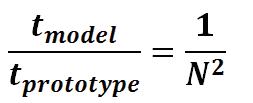
This suggests that the model consolidation rate is N 2 times faster than the prototype, which can be a major advantage in modelling many soil mechanics problems. For example, a soil sample which takes 3 years to achieve 95% consolidation could finish consolidation within 10.5 hours at 50g in the centrifuge.
On the other hand, time scales for dynamic problems which involve inertial effects need to consider a different scaling law where the time in the prototype is scaled as N rather than N 2 as is the case for diffusion events. Furthermore, the time scale for creep is unity. This conflict needs further consideration, especially in tests involving different types of events, such as stability of embankment during a seismic event. Before the seismic event, the consolidation time scales are used but during the event, significant water flow may be prevented due to relatively low
permeability and the dynamic time scaling law is applied.
In some cases, the particular problem that is being modelled needs to be considered where one aspect of soil behaviour may be more significant than others and has to be correctly modelled.
Wong, et al., [8] designed and tested a river bank slope problem where continuous tide movement resulted in a cumulative deflection of piles. The tests were carried out at the NUS Geotechnical Centrifuge Laboratory (Figure 2). The model was set up in a container with a back panel which contained a water tank that could be moved up and down (Figure 3). The tank movement draw-downs or raises the water level in the model river bank, simulating tide movements. Model piles were installed with attached
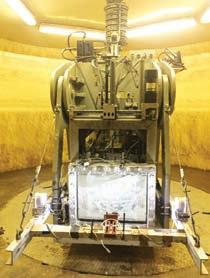

strain gauges while lasers were used to measure pile head deflection.
The maximum lateral soil movements (Figure 4) and bending moments occurred at the mid-slope locations and showed a decreasing trend over time while pile head movements were observed to increase over continuous cycles, reaching an asymptote (Figure 5).


With each cycle of drawdown, the slope moved towards the river and during the subsequent water level rise, the slope rebounded from the river but did not completely recover. Thus, a cumulative movement is seen over 50 cycles of fluctuation. Using miniature PPT embedded in the slope, it was observed that negative pore water pressures accumulated at the mid-slope and toe levels, possibly due to this cyclic shearing of the soil slope. The increase in the effective stresses due to the development of excess pore water pressure would reduce the bending moments over time. On the other hand, the creeping behaviour of the slope over each cycle would drag the pile with the slope, thus

showing a continuous increase in pile head movements.
These observations suggest that, in the short term, bending moments were more critical. Meanwhile, due to the continuing increase in pile head movement, an uncapped pile foundation system can be vulnerable when embedded in the riverbank and can face serviceability issues in the long-term.
Ong, et al., [9] and Leung, et al., [10] carried out a series of tests to determine the behaviour of piles behind a stable and failing retaining wall (see Figure 6), respectively. By controlling the amount of fluid in the latex bag, the excavation process could be sequentially modelled inflight.
The test results showed that after excavation, the generated excess negative pore pressure would dissipate, resulting in a continuous increase in pile bending moment as well as pile head movements even after the excavation had ceased.
Tunnel construction is another area where centrifuge can be used to study the detrimental effects of induced vertical and lateral movements on the existing foundations of buildings above and near the affected areas. Sharma, et al., [11] used a relatively new approach to model tunnel construction in a centrifuge i.e. by using polystyrene foam which could be dissolved in-flight using acetone. Thus, proper construction sequence can be simulated. The tunnel lining was installed with strain gauges and the surface measurements carried out with LVDT for subsequent interpretation of soil-structure interaction.
Seismic events or earthquakes are modelled in the centrifuge by using shaking tables and shear boxes. A rare and interesting case is where dams are modelled for earthquake scenarios. In case of concrete dams, the energy required to fracture and for cracks to form, is dependent on grain size. Scaling down the size of aggregates used in concrete so as

Max. bending moment increment (kN-m)


to achieve the same concrete as the prototype means that dam failure mechanism will be affected.
The scaling of energy and particle sizes will mean a special mix of concrete is required. Furthermore, in order to simulate the correct pore pressure response, high viscosity fluid has to be used to saturate the soil.
Kim, et al. [12] successfully carried out dynamic centrifuge tests on two major dam types: Earth-core rockfill dam and concrete-faced rockfill dam. They found that residual settlements and displacements were relatively small and failure mostly occurred by surface sliding. Furthermore, they verified their findings by carrying out numerical analyses. The results of the analysis closely resembled the results of centrifuge tests (Figure 7).
Offshore infrastructure, as used in the oil and gas industry, is a unique situation where environmental loading plays an important role. A lot of research has been carried out in this area, including studies on offshore foundation systems, anchoring systems, submerged pipelines and submarine landslides.
A common application in this field is to model soil-pipe interactions on a sea bed. Dingle, et al., [13] carried out studies on the embedment and lateral breakout mechanism of pipes in soft clay. Using high-resolution pictures (Figure 8) to capture soil behaviour and load displacement data from the centrifuge tests, the brittle breakout mechanism was identified.
Furthermore, soil vectors generated from the images during centrifuge testing closely followed the results from numerical studies (Figure 9).
Centrifuge technology presents many advantages in terms of time, cost, repeatability (consistency) and quality of acquired data if the centrifuge model is diligently idealised, based on the established scaling laws and sound geotechnical engineering knowledge.


While designing for strength based on a given factor of safety is still common, performance-based design is becoming as important. With the increasing number of centrifuge facilities being constructed in Asia, coupled with more innovative test methods being applied in centrifuge modelling, this means that engineers now have the opportunity to perform forensic engineering and parametric study on challenging and complex real-life geotechnical problems, which would otherwise be too costly to test (e.g. fullscale test).
The ability to study and understand a potential failure mechanism is the basis for developing innovative engineering solutions. Therefore, centrifuge modelling can be readily used to verify complex soilstructure interaction problems and to complement numerical modelling, laboratory testing as well as field observational approach.
[1] M. Bolton, "To embrace scientific performance-based design," in Special Feature on JURUTERA No 11/2013, R. K. K. Eng, Ed., ed. Malaysia: Jurutera, The Monthly Bulletin of The Institution of Engineers, Malaysia, 2013, pp. 30-35.
[2] P. B. Bucky, Use of models for the study of mining problems: American Institute of Mining and Metallurgical Engineers, Incorporated, 1931.
[3] H. Ramberg, "Instability of layered systems in the field of gravity.," Physics of the Earth and Planetary Interiors, vol. 1, pp. 427-447, 1968.
[4] P. Joseph, H. Einstein, and R. Whitman, "A literature review of geotechnical centrifuge modeling with particular emphasis on rock mechanics," Massachusetts Inst of Tech Cambridge Dept Of Civil Engineering1988.
[5] C. W. W. Ng, "The state-of-the-art centrifuge modelling of geotechnical problems at HKUST," Journal of Zhejiang University SCIENCE A, vol. 15, pp. 1-21, January 01 2014.
[6] G. Madabhushi, "Centrifuge Modelling for Civil Engineers," p. 324, 2014.
[7] S. A. Stanier and D. J. White, "Improved image-based deformation measurement for the centrifuge environment," Geotechnical Testing Journal, vol. 6, pp. 915-927, 2013.
[8] S. T. Y. Wong, D. E. L. Ong, C. F. Leung, A. Arulrajah, R. Evans, and M. M. Disfani, "Centrifuge model study of pile subjected to tidal induced
soil movement,". Second Asian Conference on Physical Modelling in Geotechnics, Shanghai, China, 2016.
[9] D. E. L. Ong, C. F. Leung, and Y. K. Chow, "Pile behavior due to excavation-induced soil movement in clay. I: Stable wall," Journal of Geotechnical and Geoenvironmental Engineering, American Society of Civil Engineers (ASCE), vol. 132, pp. 36-44, 2006.
[10] C. F. Leung, D. E. L. Ong, and Y. K. Chow, "Pile behavior due to excavation-induced soil movement in clay. II: Collapsed wall," Journal of Geotechnical and Geoenvironmental Engineering, American Society of Civil Engineers (ASCE), vol. 132, pp. 45-53, 2006.
[11] J. Sharma, M. Bolton, and R. Boyle, "A New Technique for Simulation of Tunnel Excavation in a Centrifuge," 2001.
[12] M.-K. Kim, S.-H. Lee, Y. W. Choo, and D.-S. Kim, "Seismic behaviors of earth-core and concrete-faced rock-fill dams by dynamic centrifuge tests," Soil Dynamics and Earthquake Engineering, vol. 31, pp. 1579-1593, 2011/11/01/ 2011.
[13] H. R. C. Dingle, D. J. White, and C. Gaudin, "Mechanisms of pipe embedment and lateral breakout on soft clay," Canadian Geotechnical Journal, vol. 45, pp. 636-652, 2008/05/01 2008.
[14] M. F. Randolph, C. Gaudin, S. M. Gourvenec, D. J. White, N. Boylan, and M. J. Cassidy, "Recent advances in offshore geotechnics for deep water oil and gas developments," Ocean Engineering, vol. 38, pp. 818834, 2011/05/01/ 2011.
Title: 2-Day Course on Executive Management In Primavera P6
24-25 January 2018
Organised by: Project Management Technical Division Time : 9.00 a.m. - 5.30 p.m.
CPD/PDP : 14
Title: 2-Day Seminar on "Fire Control Concept & Design of Active Wet System"
24-25 January 2018
Organised by: Building Services Technical Division Time : 8.30 a.m. - 5.15 p.m.
CPD/PDP : 13
Title: Talk on “Introduction to BIM for Civil and Structural Engineeers Series - Overview and the Malaysia Roadmap" (2nd Session)
25 January 2018
Organised by: Civil & Structural Engineering Technical Division Time : 5.30 p.m. - 7.30 p.m.
CPD/PDP : 2
Title: 5-Day Course on PMP Exam Prep Combo
5-9 February 2018
Organised by: Seniors Special Interest Group & Project Management Technical Division Time : 9.00 a.m. - 5.00 p.m.
Authors' Biodata
Ir. Assoc. Prof. Dr Dominic Ong Ek Leong, obtained his Bachelor’s Degree from the University of Western Australia (UWA) and his PhD in Geotechnical Engineering from the National University of Singapore (NUS). He is currently an Associate Professor and Director of the Research Centre for Sustainable Technologies, Faculty of Engineering, Computing & Science, Swinburne University of Technology Sarawak Campus and an EXCO Member of the Association of Consulting Engineers Malaysia (ACEM) Sarawak Branch, Vice-Chairman Institution of Engineers Malaysia (IEM) Sarawak Branch and a Founding Member of the Malaysian Geotechnical Society (MGS) and the Malaysian Society for Trenchless & Tunnelling Technology (MSTTT)
He is also an Editorial Board Member of the UK’s Institution of Civil Engineer (ICE) journal, Geotechnical Research and SEA Geotechnical Society’s Geotechnical Engineering journal.
CPD/PDP : Applying
Kindly note that the scheduled event is subject to change. Please visit the IEM website at www.myiem.org.my for more information on the upcoming events.
Congratulation to Ir. Dr Ahmad Anuar bin Othman on being promoted as State Director, Jabatan Pengairan Dan Saliran Negeri Perak (JPS) on 15 December 2017

In the 1970s, geotextiles (geosynthetics) were largely ignored by geotechnical engineers who thought the only supplier of geotechnical materials was GOD. However, the abundantly available natural soil is sometimes far from being an ideal construction engineering material. In general, soil is inherently weak in tension, shear and can be compressible with poor drainage property. Adding geosynthetics to soil would convert it into a composite material with enhanced properties.
Since the 1980s, geotextiles have progressively pervaded all branches of geotechnical engineering. This may yet be one of the most important revolutions to date in the history of geotechnical engineering.
Geosynthetics are defined as “planar products manufactured from polymeric material used with soil, rock, earth, or other geotechnical engineering related material as an integral part of a man-made product, structure or system” – ASTM Committee D35 (1984).
Geosynthetics can be formed by manufacturing processes such as extrusion, spinning, stretching, weaving and bonding. Typically, they are composed of one or more of polymers such as polyethylene (PE), polypropylene (PP), polyesters (PET), polyamide/Nylon (PA), polyvinyl chloride (PVC), Polyvinyl Alcohol (PVA), Polystyrene (PS). Geosynthetics may also be combined with carbon fibre, glass fibre, natural fibre materials and other materials such as bentonite.
In Geotechnical Engineering applications, geosynthetics can be used to separate materials, reinforce soil, permit drainage, provide filtration or act as impermeable barrier. Types of geosynthetics and their key functions are listed below:
• Geotextiles - drainage, filtration, separation, protection.
• Geogrids - reinforcement, stabilisation.
• Geomembranes -fluid barrier, liner.
• Geonets – drainage.
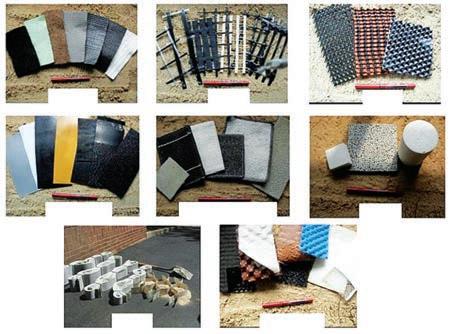
• Geofoam - lightweight fills, insulation.
• Geocomposites - liner, combination of functions.
• Electrokinetic geosynthetics –incorporates electrokinetics to traditional functions.
Geosynthetics are being used extensively in geotechnical, transportation, environmental and hydraulic engineering as well as to provide technically efficient, cost effective, environment-friendly and/ or energy-efficient solutions to a wide range of civil engineering problems. Hand in hand, rational design methods are now available, based on sound engineering concepts and standardised testing methods
to determine engineering properties to geosynthetics and geosynthetics engineered composites.
Geosynthetics Engineering is fast gaining prominence worldwide to deal with the application of scientific principles and methods to the acquisition, interpretation and use of knowledge of geosynthetic products for the solution to geotechnical, transportation, environmental, hydraulic and other civil-engineering-related problems.
Introducing any state-of-the-art technology to the local industry is never an easy task. It is particularly







challenging in the absence of specific codes of practice for such new technology or product. The new technology may have gained acceptance worldwide, but the local industry will still demand a local case history to be convinced. This is a chicken-and-egg situation. If it is not accepted in the first instance, there cannot be a local case history!
In the case of the first application of geogrid in Malaysia, the late Professor Chin Fung Kee took a bold step when he designed and introduced the application of geogrids in the Jitra-Butterworth Expressway in 1985. This small proactive action would eventually be a big step in the development of Geosynthetics Engineering in Malaysia. Since then, the achievements using geosynthetics material in engineering practice in Malaysia has been impressive.
IEM has organised many conferences, workshops and lectures to promote and develop the applications of geosynthetics here. These include:
• Symposium on Application of Geosynthetic and Geofibre in Southeast Asia (1989).
• Workshop on Geotextile Design and Applications (1992).
• 2nd Asian Geosynthetics Conference (2000).
On the international front, the International Geosynthetics Society (IGS) is dedicated to the scientific and engineering development of geotextiles, geomembranes, related products and associated technologies. (More at www.geosyntheticssociety.org).
The core purpose of IGS is to provide an understanding of and to promote the appropriate use of geosynthetic technology globally.
The society envisions that, in the near future, geosynthetics will become indispensable to the point that they will be regularly included in engineering curricula and relevant design standards.
The flagship events of IGS are the international and regional conferences. The International Conference is held once every 4 years while the Regional has the same structure but in years alternate to the International





Conference. Each national chapter hosts conferences each time. It allows the chapters to improve involvement, community and geosynthetics success locally and regionally.
Since its beginning in the early 1990s, IGS membership has grown to over 4,000 and includes corporations, professionals, individuals and students. With 43 chapters worldwide, it’s easy to be involved with the society by joining a local IGS chapter.


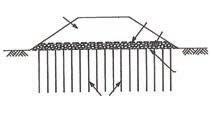






Nehemiah-OVM provides the following products and services:
- Post-tensioning solution provider
- Carpark Flat Slab
- Transfer Plate
- Beams, Box Girders
- Alternative design solutions
- Cable systems (stay cable, main cable, hanger)
- Bridge bearing and expansion joint
- Construction solutions (heavy lifting, ILM, etc)
- Monitoring, repairing and strengthening for structures





Head Office
Nehemiah Prestress Sdn Bhd 1140945-A No. 45-3, Jalan PJU 5/20
The Strand, Kota Damansara 47810 Petaling Jaya Selangor Darul Ehsan
Malaysia
Tel: (603) 6142 6638
Fax: (603) 6142 6693
Email: enquiry@nehemiahpt.com

Nehemiah A member of the Nehemiah Group

Certified by the European Organization for Technical Approval

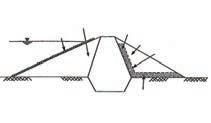
Upstream support fill Dam
IGS publishes two journals, a peer-reviewed technical journal, Geosynthetics International and Geotextiles & Geomembranes
Founded in 2014, the Malaysia Chapter (MyIGS) is officially registered as Pertubuhan IGS Malaysia. Its members comprise a healthy mix of academicians, consultants, contractors, manufacturers, distributors and installers. Over the past few years, MyIGS had collaborated with IEM’s Geotechnical Engineering Technical Division to deliver a few evening lectures and talks.
The continuous research & development in Geosynthetics Engineering is achieved through the efforts of all parties in the industry. The current infrastructure construction such as highways, railways, airports, urban developments as well as preservation of the ecological environment have all benefited tremendously through the use of this new, innovative construction material/technology in meeting the requirements of quality, time and cost.

[1] Giroud, J.P. (1986). “From Geotextiles to Geosynthetics: A Revolution in Geotechnical Engineering”. Third International Conference on Geotextiles, 1986, Vienna, Austria, pp 1-18.
[2] Chan S.F. (2000). “Reinforced Soil Structures Using Geogrids”. Geosynthetics Asia 2000, Proceedings of the 2nd Asian Geosynthetics Conference , Kuala Lumpur, Malaysia, 29-31 May 2000, pp 95-110.
[3] ICE (2012). “Handbook of Geosynthetic Engineering, second edition”. Thomas Telford ICE, UK.
[4] ICE (2012). “ICE Manual of Geotechnical Engineering, Volume II Geotechnical Design, Construction and Verification”. Thomas Telford ICE, UK, pp 1478-1479.
[5] IGS website: http://www. geosyntheticssociety.org.
[6] MyIGS:https://m.facebook. com>igsmy.
Mr. Tee Choon Heng, Director of Mega Geoproducts and Services Sdn. Bhd., is a pioneer in the application of geosynthetics in Malaysia since 1986. He distributes Tensar geogrids and involves in the design and construction of reinforced soil structures. Author's Biodata Rip-rap
Every year for the IEM Council election, some 9,000 ballot papers are sent out to corporate members Out of the 9,000, less than 2,000 papers are returned TO SAVE COSTS, PREVENT WASTAGE AND TO ENABLE MORE CORPORATE MEMBERS TO CHOOSE THE RIGHT CANDIDATE TO SERVE IN THE COUNCIL, IEM WILL BE IMPLEMENTING e-VOTING MOVING FORWARD
To enable us to put this process in place, kindly update your PERSONAL PARTICULARS column via the IEM Web Portal especially email addresses (personal email preferred over company email) and mobile phone numbers
If you have not created your username and password, please log on to www.myiem.org.my to activate your first time log in (a tutorial video is provided to assist you with that)







This article deals with drained direct shearbox tests on sand. The objective is to investigate whether the shape and size of the shearbox affect the determined friction angle (Ø).
In a direct shearbox test, soil is laterally restrained (upper box) and sheared (lower box) along a mechanically induced horizontal plane, while subjected to a pressure applied normal to that plane, as shown in Figure 1. The shearing resistance offered by the soil as one portion is made to slide on the other is measured. Failure occurs when the shearing resistance reaches the maximum value which the soil can sustain. By carrying out tests on a set (usually three) of similar specimens of the same soil under different normal pressures, the relationship between measured shear stress at failure and normal applied stress is obtained. If it can be assumed that the relationship is linear, the slope of the line and its intercept with the shear strength axis can be derived from the line of best fit through the plotted points. The slope gives the friction angle, Ø (in degrees), and the intercept gives the apparent cohesion, c (in kPa) (BS 1377-7:1990+A1).
According to the Mohr-Coulomb failure criterion, the strength or shear resistance (τ) of soil is given by:

For a non-cohesive soil, e.g. sand, c can be ignored.
One of the important variables that would affect the results of a direct

shearbox test on sand is in the state of sand packing, which can be expressed in terms of relative density, void ratio, porosity or dry density. The term relative density, which is also known as density index, ID, is used to describe the denseness or looseness of soil. The index relates dry density (or void ratio) of a soil sample or of an insitu soil, to the limiting dry densities (or limiting voids ratios). The relationship can be defined in terms of maximum and minimum dry densities as follows:

where ρd denotes the dry density of the soil in question, ρd min the dry density at the least dense state, and ρd max the dry density at the densest state.
The British Standard, BS 13774:1990+A2 contains the methods of test for determination of maximum and minimum dry densities of sand.
Subclause 4.2 of the related standard is used for the determination of maximum density and Subclause 4.4 for minimum density. Table 1 shows the commonly used qualitative descriptions of granular soil deposits.
The British Standard (BS) describing
Table 1: Qualitative descriptions of granular soil deposits
DESCRIPTION RELATIVE DENSITY, ACCORDING TO LAMBE AND WHITMAN (1969) (%) RELATIVE DENSITY, ACCORDING TO DAS AND SOBHAN (2014) (%) Very loose 0 - 15 0 - 15



methods of test for soils for civil engineering purposes is BS 1377. This series contains nine parts, in which Part 7 contains the methods of test for direct shear. Clause 4 – Determination of shear strength by direct shear (small shearbox apparatus) in BS 13777:1990+A1 is applicable in this study.
The American Society for Testing and Materials (ASTM), since 1898, is one of the largest voluntary standards developing organisations in the world. The direct shearbox test reference is ASTM D3080/D3080M: 2011 Standard test method for direct shear test of soils under consolidated drained conditions.
In this study, the British Standard is used for shearbox of square shape and the ASTM Standard for the circular shape. It is noted that the BS covers only square shaped shearboxes while the ASTM covers both the square and circular shapes.
The project problem is defined by deductive reasoning on how the box shape and size will influence the friction angle determined by a direct shearbox test. In a narrow sense, two types of sand with different grading are considered in order to effectively manage the project deliverables. The three relevant aspects (variables) of interest are: (a) box shape and size, (b) relative density, and (c) friction angle. The concepts relating to the variables can then be developed into a theoretical framework.
As a technical condition or prerequisite, “relative density” can be a moderating variable that is related to the test method which delivers the result. The prevalent theory is that the “friction angle” is influenced by the “Test Method”. Only the relative density seems to contribute to friction angle. In the preceding situation, friction angle is the dependent variable that will be positively influenced by the box shape and size (independent variable). Thus, the conceptual relationship between Test Method and Result has now
TEST METHOD
Box Shapes and Sizes
INDEPENDENT VARIABLE (the causes)

RESULT
Friction Angle
DEPENDENT VARIABLE (the effects)
PROCEDURE
Relative Density
MODERATING VARIABLE (conditional)
become contingent on the Procedure (categorised as either loose or dense) in acting as a catalyst. This Procedure becomes the moderating variable. The concepts relating to variables and the theoretical framework are presented in Figure 1.
While the study of friction angle (dependent) can influence box shape and size (independent) in a certain way, the possibility of the relative density (moderating) variable in modifying the independent and dependent relationship can also present a contingent effect. In other words, box shape and size can be selected independently with the expected or perceived friction angle and the relative density effects. However, to apply the potential benefits of box shapes and sizes, the friction angle will have to be analysed and verified by conducting laboratory tests at pre-determined or controlled cause-effect relationships.
Other than the direct shearbox test, the study also involves other related laboratory tests to characterise the sand sample used. The five related laboratory tests are bulk density, particle density (or specific gravity), maximum dry density, minimum dry density and particle size distribution tests.
1. Bulk Density Test: This is performed according to BS 1377-2:1990+A1, Subclause 7.2
– Linear measurement method. This procedure applies to soils that can be formed into a regular geometric shape, the volume of which could be calculated from linear measurements of known area of the box and the height of the test specimen. The test specimen density, ρ (in Mg/m3), is calculated from the following equation.

where m denotes the specimen mass (in g), A the specimen area (in mm2), and H the specimen height (in mm).
2. Particle Density Test: This is performed according to BS 13772:1990+A1, Subclause 8.3 – Small pyknometer method. This test is suitable for soils consisting of particles finer than 2 mm. The particle density of the soil, ρs (in Mg/m3), is calculated from the following equation. where m1 denotes the mass of density bottle; m2 the mass of bottle and dry soil; m3 the mass of bottle, soil and water; and m4 the mass of bottle when full water only.

3. Maximum and Minimum Dry Density Tests: These are performed according to BS 1377-4:1990+A2,












Notes:
1. d10, d30 and d60 denote the diameters corresponding to 10%, 30% and 60% finer, respectively, in Figure 3.
2. Cc denotes the coefficient of gradation or coefficient of curvature, and Cu the uniformity coefficient.










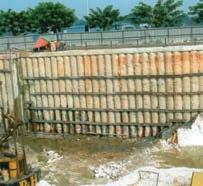


Subclause 4.2 – Determination of maximum density of sands and Subclause 4.4 – Minimum density of sands, respectively. The density index, ID (%) can be calculated from Eq. (2).
4. Particle Size Distribution Test: This test is performed according to BS 1377-2:1990+A1, Clause 9 –Determination of particle size distribution. The test specimen is verified to meet the requirements specified in BS882:1992, under the coarse sand limits (dash lines in Figure 3).
1. Sample Type: The sand used in this project is characterised using the five related laboratory tests described in Section 4. The results obtained are summarised in Table 2 and Figure 3. The grain size of the coarse sand is verified to be suitable and meets the requirements of the small shearbox apparatus, as follows:
• The size of the largest particle (22.5mm) shall not exceed one-tenth of the height of the specimen of 20 to 25mm box height.
• The minimum specimen diameter for circular specimens, or width for square specimens, shall be 50mm or not less than 10 times the maximum particle size diameter, whichever is larger, and shall conform to the width to thickness ratio of 2.
• The minimum initial specimen thickness shall be 0.5 in. (12 mm), but not less than six times the maximum particle diameter.
2. Shearbox Test Specimen: It is necessary to have a Procedure to replicate sand preparation to the specified dry density so that results of the friction angle in the Test Method can be compared and validated. A trial and error procedure is used in a test specimen preparation. The proportion of the sample to be well-graded in test specimen is prepared. The specified dry densities for loose (L), medium dense (MD) and dense (D) are
then based on determined index of relative density. The computed density values are derived from relative density and are summarised in Table 3.
3. Method of Sand Deposition: A loose test specimen is prepared according to BS 1377-7:1990+A1, Subclause 4.4.4.2 – Dry Sand: Loose. The loose density state is achieved by rapid pouring of a test specimen into the shear box from a small height (25mm). The surface of the specimen is levelled using a suitable tool (extrusion dolly) to achieve the required thickness. The required soil weight for specified loose density is presented in Table 3. A medium dense or dense test specimen is prepared according to BS 13771:1990+A1, Subclause 7.7.4.2.2 –Compaction to specified density. The specimen is compacted in the shearbox in three different layers by light tamping for 25 times per layer. The required soil weight for specified dense density is presented in Table 3. The sample designation for each test specimen is presented in Table 4.
The friction angles obtained from all the shearbox tests performed are presented in Table 5. A total of 24 cases are studied, i.e. 2 (grading: poorly-graded & well-graded) × 2 (shape: square and circular) × 2 (size: 60 mm and 100 mm) × 3 (relative density: loose, medium dense and dense) = 24 cases. The friction angles are projected by best line fit, on the assumption that there is no cohesion for remoulded coarse sand. The ultimate shear strengths are taken at the end


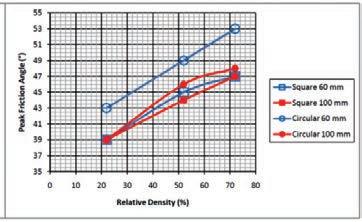





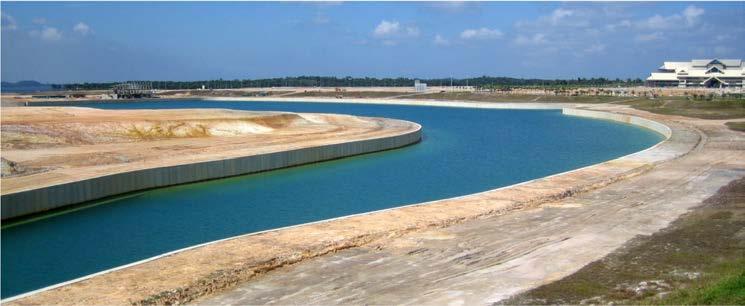


of 10 mm travel (displacement) of the box capacity. From the stress paths analysis, noticeable peak shear strengths are observed in the medium dense and dense states.
The ultimate and peak friction angles of sand as a function of relative density are presented in Figure 4 for the poorly-graded sand, and Figure 5 for the well-graded sand. The following observations can be made from Figures 4 and 5.
a) In all cases, the peak friction angle increases with relative density.
b) The ultimate friction angle is not or slightly affected by relative density.
c) In most cases, the ultimate and peak friction angles decrease with shearbox size. Hence, the use of shearbox size of 60 mm in determining friction angle may be risky.
d) In general, for the shearbox size of 100 mm, square and circular shearboxes give approximately
the same friction angles with an occasional maximum variation of about 2º
e) However, for shearbox size of 60 mm, the square and circular shearboxes give different friction angles in most cases with a general variation range of about 3º to 6º
The following conclusions can be drawn from this study:
1. The ultimate and peak friction angles decrease with shearbox size. The use of shearbox size of 60 mm in determining friction angles may be risky.
2. Compared to the shearbox size of 60 mm, the square and circular shearboxes of size of 100 mm give more similar friction angle values.
3. Shearbox size of 100 mm, either square or circular, is preferable to the size of 60 mm in determining ultimate and peak friction angles.
[1] ASTM D 3080/3080M:2011, Standard Test Method for Direct Shear Test of Soils under Consolidated Drained Conditions
[2] BS 1377:1990 (Parts 1, 2, 4 and 7), British Standard Method of test for soils for civil engineering purposes , Parts 1, 2, 7 and 4.
[3] Das B.M. and Sobhan K. Principles of Geotechnical Engineering . 8th Ed., Cengage Learning, Australia, 2014.
[4] Lambe T.W. and Whitman R.V. Soil Mechanics . John Wiley & Sons, New York, 1969.
Ir. Dr Chan Swee Huat, obtained his PhD degree from the National University of Singapore in 2003. He is a Committee Member of IEM GETD and the Hon. Treasurer of Malaysian Geotechnical Society. He is a Director of Geo-Excel Consultants Sdn. Bhd. Since graduation from Universiti Kebangsaan Malaysia in 1997, he has been involved in the design and construction of various geotechnical engineering works.
Wong Soon Yee, graduated in Master of Engineering with Honours in Civil Engineering from University of Nottingham Malaysia Campus. He then pursued a Doctor of Philosophy degree in Civil Engineering at the same University since September 2014. He has part-time industry experience at Soilpro Technical Services Sdn. Bhd.
Dr Wong Kim Yuen, graduated in Doctor of Business Administration from the University of South Australia. He is the Principal Partner and Managing Director of Soilpro Technical Services Sdn. Bhd., the Vice President (2016/18) of The Malaysian Site Investigators Association, MSIA and a member of Technical Committee on Geotechnical Works (TC/D/17) for ISC/D managed by SIRIM Berhad.
Title: Technical Visit to Nuri Refinery Sime Darby Plantation Sdn. Bhd.
8 February 2018
Organised by: Mechanical Engineering Technical Division
Time : 9.00 a.m. - 1.00 p.m.
CPD/PDP : Applying
Title: Talk on Process Safety Management for Zone 2 Diesel Engine
10 February 2018
Organised by: Chemical Engineering Technical Division
Time : 5.30 p.m. - 7.30 p.m.
CPD/PDP : Applying
Kindly note that the scheduled event is subject to change. Please visit the IEM website at www.myiem.org.my for more information on the upcoming events.
reported by

IEM’s Geotechnical Engineering Technical Division (GETD) invited Er. Dr Oskar Sigl of Geoconsult Asia Singapore and Er. Dr Goh Kok Hun of Land Transport Authority of Singapore, to deliver a talk at the Hilton Petaling Jaya Hotel on 22 August, 2017. The seminar, chaired by Ir. Dr Gue Chang Shin, was attended by 128 participants. It covered four key areas:
• Evaluating the impact of underground construction on buildings.
• Analysis of ground movements: Simplified approaches for difficult situation.
• Influence of building stiffness and case studies of building response to underground construction.
• Analysis and impact assessment of underground construction on existing rail infrastructures.
Dr Goh began the first session by showing that main movements due to underground constructions are typically from tunnelling and deep excavations. Ground movements, particularly settlements from tunnelling, can be reasonably predicted using Gaussian curves based on volume loss (volume of surface settlement trough over the volume of excavated tunnel).
For deep excavations, Finite Element Method (FEM) is valuable in modelling construction processes where various stages of excavations
Preliminary assessment: Yes
Second stage assessment:
Detailed evaluation:
Is settlement <10mm and slope <1:500?
Calculate tensile strain based on greenfield movements
Tensile strain within acceptable limits?
Detailed evaluation
Negligible risk of damage
Using deflection ratios (∆ / L) & average horizontal strains (ɛh)
Potential damage category up to Slight
Implement protective and / or mitigating measures if risk of damage is still unacceptable
can be simulated. It is also useful to verify FEM using empirical correlations. He then introduced the framework for a 3-staged risk assessment of building damage as depicted in Figure 1. It is important to note that categories of damage are related to induced tensile strains.
In the second session, Dr Sigl pointed out that conservatism is relative. Structural analysis is based on the Ultimate Limit State whereas geotechnical analysis is based on Serviceability Limit State, where both have divergent input requirements. He highlighted some limitations of
2D analysis which can be overcome by 3D analysis. However, 3D analyses become complicated for geometries with subdivisions.
He then moved on to a simplified approach for complicated situations. For estimating greenfield tunnelling-induced settlements, the use of volume loss approach (i.e. conventional tunnelling-induced ground settlement equations) can simplify 3D settlement analyses. The approach is to create a 3D model for a single excavation advancement for which the incremental settlement value in the 3D model is determined.
Yes! I would like to be a subscriber of The Institution of Engineers, Malaysia’s publications
Name: _________________________________________________________________________________________________________
Mailing Address: _________________________________________________________________________________________________
Country: ________________________
Company/Institution: ______________________________________________________________________________________________
Title: ____________________________________________________________________________________________________
Telephone No: _________________________ Fax: _________________________ Email: _________________________________
New Subscriber Renewal
Please commence my subscription from: _________________________(month/year) Signature: _______________________________
To start your subscription of IEM’s publications, complete this form and mail it back to the address below. For faster processing, fax it to: +603 7493 1047. Thank you.
What is your primary job title?
Corporate Management (including chairman, president, proprietor, partner, director, vice president, general manager, division manager, import/export manager, other corporate title)
Management (including project/contract/equipment/service/transport district manager, clerk of works, other technical or operating manager)
Engineering/Design (including chief engineer, chief designer, civil/ highway/mechanical/planning engineer, other engineering/design title)
Buying/Purchasing (including chief buyer, buyer, purchasing officer, other buying/purchasing title)
Titles allied to the field (architect, consultant, surveyor, research and development professor, lecturer, supervisor, superintendent, inspector or other allied title)
Others (please specify) ____________________________
What type of organisation do you work in? (Tick one box only)
Contractor
Sub-contractor specialist
Design and build contractor
Consulting engineering/architectural/quantity surveying practice
Mining/quarrying/aggregate production company
Petroleum producer
International/national authorities
National/regional/local government
Public utilities (electricity, gas, water, deck and harbour, other)
Manufacturer
Distributor/importer/agent
Construction department of large industrial/Commercial concern
Association/education establishment/research
Construction equipment hire/rental company
Project/construction management consultancy
Others (please specify) _______________________________
What are the main activities of your organisation? (Tick all that apply)
Constructions of:
Roads/bridges

Manufacturer of:
Construction equipment
Dams/reservoirs/irrigation Cement
Harbours/offshore structures Other construction materials
Foundations/tunnels
Distribution Pipelines/refineries Construction equipment
Structures/steel work
Construction materials
Building (commercial, industrial) Hire/rental of construction equipment
Housing Design
Construction management Earth-moving/open cast mining
Deep mining Aggregate production
Others (Please specify) _________________________________________
Rate (Please tick)
RM360.00 - 12 issues of JURUTERA
RM84.00 - 2 issues IEM Journal (Half-yearly)
Terms and Conditions:
1) The subscription is to be prepaid.
2) Please make cheque payable to Dimension Publishing Sdn. Bhd.
3) Subscriptions are not refundable.
4) Magazine/s will be sent to the mailing address given.
5) Students are entitled for a 20% discount from the above subscription rate.
6) Students must submit a photocopy of the student identification card together with the payment.
7) The above rate is inclusive of delivery charges and applicable in Malaysia only.
8) Additional delivery charges will apply to overseas subscribers.
For subscription enquiries, please contact +603-7493 1049 or email to info@dimensionpublishing.com


Hollow core slabs, planks, precast columns & beams, precast walls, precast staircases, and other customized structural concrete products.
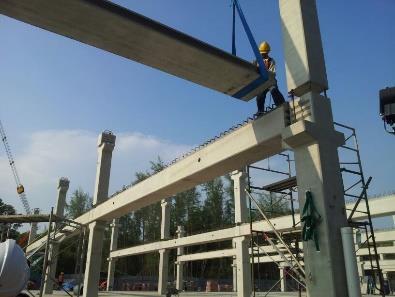

The equivalent volume loss is then back-analysed by matching the settlement troughs from both analyses. This calibrated volume loss value is subsequently adopted as an input for the conventional ground settlement analyses to extrapolate settlements for the entire length of tunnel within comparable geology.
The third session was on the influence of building stiffness that had significant influence on its response to excavation as well as tunnelling induced movements. Dr Goh presented the concept of modification factor as a means to quantify the relative building settlements to greenfield. He then showed a useful chart that indicated a consistent relationship between these modification factors and building relative stiffness from field monitoring. For example, buildings with relative stiffness of more than 1.0 is considered rigid and are expected to experience little or no differential settlements. Dr Goh said that, by assuming buildings conform to greenfield, settlement conditions will overestimate the damage category. He also said that horizontal strains induced in buildings are often very small. Some case studies were presented and these showed that tunnelling directly below buildings do not generally cause building to settle much more than the ground. The key is to limit ground deformations by applying good tunnelling controls.
In the fourth session, Dr Sigl shared the principles of impact assessment approach for existing rail infrastructure. The maximum movement limits applied to rail infrastructures in Singapore are typically less than 15mm, with a maximum gradient change (distortion) of less than 1:1000. It is interesting to note that Malaysia enforces an even more stringent criterion where distortion is limited to 1:2000, as stipulated in the Malaysia Railways Act 1999.

28, Jalan7/108C,Taman Sg. Besi, 57100 Kuala Lumpur. Tel: +603-7980 2728 Fax: +603-7980 5662 www.epmsb.com.my
We are ISO9001, ISO14001, OHSAS18001 & ISO22301 Certified
Dr Sigl also identified some of the limit states in tunnels and railway tracks and the potential effects. Some typical control values for “Alarm” and “Limit” levels were provided but he stressed that control values need to be assessed on a case-to-case basis, where pre-existing conditions need to be taken into account. Various cases studies, where complex analyses were carried out for the impact assessments, were then discussed.
The seminar ended with rounds of applause from the audience and then, GETD Chairman Ir. Lee Pier Tien presented tokens of appreciation to Er. Dr Oskar Sigl and Er. Dr Goh Kok Hun (Figure 2).
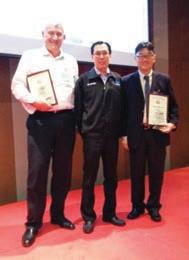
reported by

Mr. Piotr Mazurowski from Tensar International gave an evening talk on MechanisticEmpirical Pavement Design (M-E) with Hexagonal Geogrids on 19 September, 2017, at the Tan Sri Prof. Chin Fung Kee Auditorium, Wisma IEM. Mr. Mazurowski has over 17 years’ experience in pavement and geotechnical engineering.
The talk was organised by the Geotechnical Engineering Technical Division, and 38 participants attended. The purpose was to introduce the benefits of hexagonal geogrids in pavement design, the rationale design approach using mechanisticempirical methods incorporating geogrids, the test results and case studies on the use of hexagonal geogrids. This method is an elegant approach to pavement design, incorporating sound theoretical knowledge and empirical testing of pavement materials under traffic loading.
First, Mr. Mazurowski introduced the concept of Mechanically Stabilised Layer (MSL). The bearing capacity of MSL is improved where the aggregate particles are confined within the stiff geogrid appertures through the mechanism of interlocking. He presented a short overview of the M-E design methods in 3 stages:
1. Pavement modelling in layered elastic analysis software.
2. Calculation of pavement response

(strains & stresses) to single ESAL.
3. Calculation of pavement life for the pavement layers – number of ESAL to reach damage level using transfer functions ( fatigue criteria).
The design of flexible pavements using MSL, allows reduction of pavement layers (including asphalt layers) while maintaining pavement life or increasing pavement life and maintaining the thickness or a combination of both.
The modelling of the hexagonal geogrids in the pavement design method is carried out by:
1. Using Stiffness Enhancement Concept where the stiffness of unbound aggregates is increased in Linear Elastic Analysis (LEA).
2. Using Stiffness Retention Concept where it is modelled with shift factors. In post LEA, the calculated life (fatigue and subgrade deformation life) is multiplied by a shift factor.
The results of the following tests were carried out to validate the performance of MSL and the stiffness increase using hexagonal geogrids:
1. Accelerated plate bearing tests, triaxial tests and PennState Smart Particle tests.
2. Full scale accelerated pavement testing was used to calibrate the empirical based shift factors.
Mr. Mazurowski also presented the following case studies where hexagonal geogrids and the design method had been successfully implemented, tested and validated.
1. Finningley & Rossington Route Regeneration Scheme (UK)
2. Rzepin By-pass – Voivodeship Road (Poland)
3. Test section in Gliwice (Poland).
Finally, he took questions from the floor, after which he was presented with a token of appreciation and the seminar ended at 7.00 p.m.

























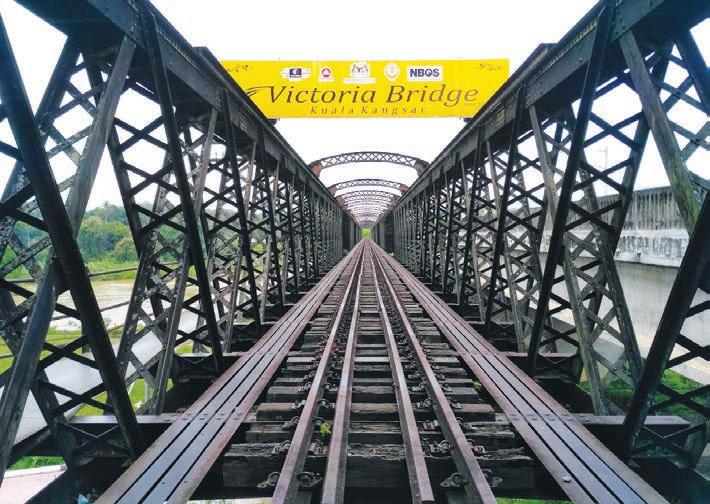
Victoria Bridge is located at Enggor which is about 6km to the northeast of Kuala Kangsar town in Perak Darul Ridzuan. It is one of the oldest railway bridges constructed by the British in Malaya. Construction began in December 1897 and the single track bridge was completed in March 1900. The steel truss rests on 6 intermediate piers and spans approximately 353 metres across the Sungai Perak. With the completion of an adjacent reinforced concrete bridge designed for double track operation, Victoria Bridge is now used by motorcyclists and pedestrians.
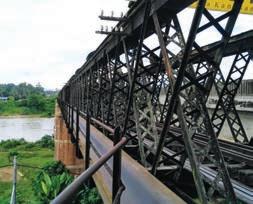

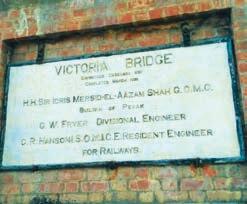
Publisher:
Explore our full set of Professional and Integrated PUBLISHING MANAGEMENT SERVICES:
» Project Management
» Creative Management
» Ad Space Management
» Mailing Management
» Print Management
• Annual Reports
• Booklets • Brochures
• Buntings • Business Cards
• CD / DVD Replications
• Calendars • Cards & Invitations
• Certificates • Custom Printings
• Envelopes • Folders
• NCR Bill Books • Notepads
• Leaflets • Letterheads
• Paper Bags • Posters
• Stickers • Others









































Dimension Publishing Sdn Bhd (449732-T) Level 18-01-03, PJX-HM Shah Tower, No. 16A, Persiaran Barat, 46050 Petaling Jaya, Selangor Darul Ehsan, Malaysia. Tel: +603 7493 1049 Fax: +603 7493 1047 E-mail: info@dimensionpublishing.com Shirley Tham : +6016 283 3013Joseph How : +6011 1234 8181

JURUTERA has an estimated readership of 168,000 professionals. Our esteemed readership consists of certified engineers, decision making corporate leaders, CEOs, government officials, project directors, entrepreneurs, project consultants, engineering consulting firms and companies involved with engineering products and services.
Our business partners can be assured that their products and services will be given the circulation and exposure it deserves, thus maintaining a sustained advertising presence to our core readers of decision-making engineers and technical experts. Our website offers an even wider market reach, with added international presence, aided by our international affiliation with official engineering bodies all over the world. Our online and offline advertising features such as banner advertising, article sponsorship and direct e-mail announcements have proven to be successful marketing strategies that will set the businesses of our partners apart from their competition.
For advertising enquiries, please contact:















TIr. Chin Mee Poon www.facebook.com/chinmeepoon
Chin Mee Poon is a retired civil engineer who derives a great deal of joy and satisfaction from travelling to different parts of the globe, capturing fascinating insights of the places and people he encounters and sharing his experiences with others through his photographs and writing.
he Clifton Suspension Bridge, spanning the Avon Gorge and linking Clifton in Bristol to Leigh Woods in North Somerset, England, was completed in 1864. It is still serving its purpose well after more than 150 years.
With a central span of 214.05m and an overall length of 412m, the bridge is justifiably famous for its setting as much as for its pioneer status as one of the earliest and finest precursors of modern suspension bridges.
The principal load-bearing members of the bridge are 3 wroughtiron chains at each edge of the carriageway suspended from the pylons.
When my wife and I were backpacking in England and Wales in March 2017, we made a day trip to Bristol from Bath. The first spot we visited in Bristol was Clifton Bridge, just 5 minutes’ walk from the bus stop in Clifton Village. A visitors’ centre was added in 2015 near the bridge abutment on Leigh Woods side. We spent two hours at the bridge and in the visitors’ centre.
The idea of a bridge over the chasm at this spot was mooted way back in mid-1700s, but nothing was done until 1829 when a competition was held for the design of a suspension bridge for the site. Twenty-two entries were received, including 4 from the great engineer Isambard Kingdom Brunel, but the judge, Thomas Telford, another great engineer of the 19th century, rejected them all as being impractical. Telford’s own design, submitted subsequently, was also rejected by the committee.
A second competition was held the following year and Isambard Kingdom

Brunel’s design was chosen as the winner. Construction work started in June 1831 but soon stopped due to severe riots in Bristol. Work resumed in 1836 but was woefully slow due to a shortage of funds.
The two pylons were finally completed in 1843 but no further work was done on the bridge until 1862. By then Brunel had passed away on 15 September, 1859, at the age of 53 and his colleagues in the Institution of Civil Engineers, William Henry Barlow and Sir John Hawkshaw in particular, amended his design in some significant ways, including raising the bridge deck, making it sturdier and increasing the number of chains from two to three. They also managed to raise enough money to complete the bridge as a tribute to Brunel.
The bridge was finally completed in 1864 and officially opened to traffic on 8 December. Since then the bridge has witnessed the first modern bungee jump from its deck on 1 April, 1979. It
has also become somewhat notorious as a suicide bridge as many people have jumped over its edge to their death.
I.K. Brunel was undisputedly one of the greatest engineers of the 19th century. He was an ingenious and prolific engineer, who built dockyards, steamships, the Great Western Railway and many important bridges and tunnels in his short but illustrious life. Among his most outstanding achievements were the first tunnel under a navigable river and development of SS Great Britain, the first propeller-driven ocean-going iron ship which was also the largest ever of its time when completed in 1843.
His name itself is considered a novelty of sorts. Isambard Kingdom Brunel sounds somewhat like “Islamabad, Kingdom of Brunei”, doesn’t it? His first given name actually came from his father, Marc Isambard Brunel, and his middle name was his mother’s surname.
Yes! I would like to be a subscriber of The Institution of Engineers, Malaysia’s publications
Name: _________________________________________________________________________________________________________
Mailing Address: _________________________________________________________________________________________________
Country: ________________________
Company/Institution: ______________________________________________________________________________________________
Title: ____________________________________________________________________________________________________
Telephone No: _________________________ Fax: _________________________ Email: _________________________________
New Subscriber Renewal
Please commence my subscription from: _________________________(month/year) Signature: _______________________________
To start your subscription of IEM’s publications, complete this form and mail it back to the address below. For faster processing, fax it to: +603 7493 1047. Thank you.
What is your primary job title?
Corporate Management (including chairman, president, proprietor, partner, director, vice president, general manager, division manager, import/export manager, other corporate title)
Management (including project/contract/equipment/service/transport district manager, clerk of works, other technical or operating manager)
Engineering/Design (including chief engineer, chief designer, civil/ highway/mechanical/planning engineer, other engineering/design title)
Buying/Purchasing (including chief buyer, buyer, purchasing officer, other buying/purchasing title)
Titles allied to the field (architect, consultant, surveyor, research and development professor, lecturer, supervisor, superintendent, inspector or other allied title)
Others (please specify) ____________________________
What type of organisation do you work in? (Tick one box only)
Contractor
Sub-contractor specialist
Design and build contractor
Consulting engineering/architectural/quantity surveying practice
Mining/quarrying/aggregate production company
Petroleum producer
International/national authorities
National/regional/local government
Public utilities (electricity, gas, water, deck and harbour, other)
Manufacturer
Distributor/importer/agent
Construction department of large industrial/Commercial concern
Association/education establishment/research
Construction equipment hire/rental company
Project/construction management consultancy
Others (please specify) _______________________________
What are the main activities of your organisation? (Tick all that apply)
Constructions of:
Roads/bridges

Manufacturer of:
Construction equipment
Dams/reservoirs/irrigation Cement
Harbours/offshore structures Other construction materials
Foundations/tunnels
Distribution Pipelines/refineries Construction equipment
Structures/steel work
Construction materials
Building (commercial, industrial) Hire/rental of construction equipment
Housing Design
Construction management Earth-moving/open cast mining
Deep mining Aggregate production
Others (Please specify) _________________________________________
Rate (Please tick)
RM360.00 - 12 issues of JURUTERA
RM84.00 - 2 issues IEM Journal (Half-yearly)
Terms and Conditions:
1) The subscription is to be prepaid.
2) Please make cheque payable to Dimension Publishing Sdn. Bhd.
3) Subscriptions are not refundable.
4) Magazine/s will be sent to the mailing address given.
5) Students are entitled for a 20% discount from the above subscription rate.
6) Students must submit a photocopy of the student identification card together with the payment.
7) The above rate is inclusive of delivery charges and applicable in Malaysia only.
8) Additional delivery charges will apply to overseas subscribers.
For subscription enquiries, please contact +603-7493 1049 or email to info@dimensionpublishing.com
Kepada Semua Ahli,
Tarikh: 16 Disember 2017
Berikut adalah senarai calon yang layak untuk menduduki Temuduga Profesional bagi tahun 2017.
Mengikut Undang-Undang Kecil IEM, Seksyen 3.8, nama-nama seperti tersenarai berikut diterbitkan sebagai calon-calon yang layak untuk menjadi Ahli Institusi, dengan syarat bahawa mereka lulus Temuduga Profesional tahun 2017.
Sekiranya terdapat Ahli Korporat yang mempunyai bantahan terhadap mana-mana calon yang didapati tidak sesuai untuk menduduki Temuduga Profesional, surat bantahan boleh dikemukakan kepada Setiausaha Kehormat, IEM. Surat bantahan hendaklah dikemukakan sebulan dari tarikh penerbitan dikeluarkan.
Ir. Yap Soon Hoe Setiausaha Kehormat, IEM
PERMOHONAN BARU
Nama Kelayakan
KEJURUTERAAN AWAM
AHMAD REDUAN BIN KHAIRUDDIN BE HONS (UiTM) (CIVIL, 2007) ME (UPM) (HIGHWAY, 2016)
YASMIN BINTI ABDUL RASHEED
KHAN BE HONS (UTM) (CIVIL, 2009)
MOHAD ‘FEDDER BIN MUSA BE HONS (UTM) (CIVIL, 2001)
ME (UTM) (PROJECT MANAGEMENT, 2014)
QUEK KENG HUA BE HONS (LEEDS) (CIVIL & STRUCTURE, 2005) ME (UTM) (CIVIL & STRUCTURE, 2010)
MOHD AZNI BIN MUSA BE HONS (CIVIL, 2007)
SALFARINA BINTI MOHD SHARIF BE HONS (KUiTTHO) (CIVIL, 2003)
KHIRLUDDIN BIN DARUS BE HONS (UTM) (CIVIL, 2000)
NOOR AKMA BINTI MOHD NARU BE HONS (UTM) (CIVIL, 2013)
SITI FATIMAH BT MOHD ZUKI BE HONS (UTM) (CIVIL, 2013)
BONG TING TING BE HONS (UTM) (CIVIL, 2006)
RAFIDAH BINTI MUSTAFA BE HONS (UiTM) (CIVIL, 2002)
KHAIRUL NIZAM BIN YUSOFF BE HONS (UTM) (CIVIL, 2001) ME (UTM) (PROJECT MANAGEMENT, 2014)
MOHD FARHAN IZZAUDDEN B ABU TAIB BE HONS (UMP) (CIVIL, 2011)
DAYANG MARINA SABRINA BINTI SAFRI BE HONS (UTM) (CIVIL, 2006)
NOR ATIKAH BINTI DIN BE HONS (UTM) (CIVIL, 2008)
SAIFUL AZZUAN BIN AZNAM BE HONS (UTM) (CIVIL, 2000)
SHAIFUL AZHARI BIN AHMAD BE HONS (UTM) (CIVIL, 2001)
SANISAH BINTI SULAIMAN BE HONS (UiTM) (CIVIL, 2004) ME (UPM) (WATER, 2014)
MOHD SUHAILI BIN ISMAIL BE HONS (USM) (CIVIL, 1998) ME (USM) (CIVIL, 2006)
SALAWATI BINTI SALLAN BE HONS (UTM) (CIVIL, 2005)
ALINA BINTI KAMDAN BE HONS (UTM) (CIVIL, 2000)
HASRUL NIZAM BIN ABDUL RAHMAN BE HONS (UKM) (CIVIL, 1999)
SITI SHAZWANI BINT MOHD NAWI BE HONS (UTHM) (CIVIL, 2009) ME (UPM) (HIGHWAY & TRANSPORTATION, 2011)
KHADIJAH BINTI BASAR BE HONS (UTM) (CIVIL, 2002)
NURAFINA BINTI SAFRI BE HONS (UNIMAS) (CIVIL, 2006) ME (UNIMAS) (CIVIL, 2010)
SITI NOREENNA BINTI MOHD
YUSOF BE HONS (UPM) (CIVIL, 2005)
QOTRUNNADA BINTI ABD RAHMAN BE HONS (UTM) (CIVIL, 2010) ME (UTM) (STRUCTURE, 2015)
AHMAD FAZILI BIN ABDUL HAMID BE HONS (UMS) (CIVIL, 1999)
ADLY BIN DASRIL BE HONS (UTM) (CIVIL, 2006)
AMMAR BIN AZMI BE (MINNESOTA) (CIVIL, 2011)
AZLAN BIN ADNAN BSc (CALIFORNIA STATE) (CIVIL, 1985) ME (UTM) (STRUCTURE, 1989) PhD (UTM) (1998)
MOHD FAIZARUDIN BIN MOHD
NOOR BE HONS (UiTM) (CIVIL, 2006)
SYARINA BINTI BADRULZAMAN BE HONS (UTM) (CIVIL, 2008)
MUHAMMAD HELMI BIN RAMLI BE HONS (UiTM) (CIVIL, 2010)
SYAHIDA BINTI ARIPIN BE HONS (UTM) (CIVIL, 2005) MSc (UTM) (CONSTRUCTION MANAGEMENT, 2006)
PENG SHER SEONG BE HONS (UKM) (CIVIL & ENVIRONMENTAL, 2007)
AHMAD SUHAIMI BIN MOHAMAD ZAMRI BE HONS (UTM) (CIVIL, 2009)
RIZALMAN BIN DARUS BE HONS (UKM) (CIVIL, 1999)
DEVAGARAN A/L SAMUGAVELU BE HONS (UM) (CIVIL, 2005) MSc (USM) (BUILDING TECHNOLOGY, 2015)
KHADIJAH BINTI OSMAN BE HONS (UiTM) (CIVIL, 2010) MSc (UiTM) (GEOTECHNIC, 2015)
MOHD HILMI BIN MALEK BE HONS (UTM) (CIVIL, 2009)
AZME BIN HASSAN BSc HONS (LEEDS) (CIVIL, 1984)
ASRUL EFFENDI BIN JAMLUS BE HONS (UTM) (CONSTRUCTION MANAGEMENT, 2007)
FAIZAL ASHRAF BIN IBRAHIM BE HONS (UPM) (CIVIL, 1998)
SRI RAHAYU BINTI NIK SAAD BE HONS (UTM) (CIVIL, 2005)
MOHD HAILMEY BIN MUSTAFA BE HONS (UTHM) (CIVIL, 2008)
NORHAIZURA BINTI YAHYA BE HONS (KUiTTHO) (CIVIL, 2006)
GILBERT WONG PAK KAI BE HONS (LEEDS) (CIVIL & STRUCTURE, 2008) ME (UNIMAS) (CIVIL, 2012)
JAMALIAH BT. ALI BE HONS (UTM) (CIVIL, 1990)
SHAHRIL BIN TAHIRIN BE HONS (UiTM) (CIVIL, 2010)
AZMI BIN OMAR BE HONS (PORTSMOUTH) (CIVIL, 1997)
AHMAD HASRUL RIZAL BIN
ABDULLAH BE HONS (UTHM) (CIVIL, 2013)
MOHD IZAINUDIN BIN IBRAHIM BE HONS (UTM) (CIVIL, 2002)
MOHD HAROMA BIN ISMAIL BE HONS (UTM) (CIVIL, 1996)
DANION A/L LEWIS BE HONS (USM) (CIVIL, 2001)
MOHD KHAIRIE BIN HASAN BE HONS (UiTM) (CIVIL, 2008)
MOHAMED TALMIZI BIN MOHD
YUSOFF BE HONS (ABERDEEN) (CIVIL, 1987)
MOHD HAFIZ BIN YAHYA BE HONS (UTM) (CIVIL, 2006)
ABD RAHIM BIN MOHAMAD YUSOB BE HONS (UiTM) (CIVIL, 2007)
MOHD AZIZI BIN ABDULLAH BE HONS (UTM) (CIVIL, 2006)
MUSTAFA BIN MURAD BE HONS (UTM) (CIVIL, 2000)
LIM KEAT ENG BE HONS (UTM) (CIVIL, 1999) ME (ASSET MANAGEMENT & FACILITIES, 2011)
HANIZAN BINTI MUKHTAR BE HONS (UTM) (CIVIL, 2003) MSc (USM) (CIVIL, 2012)
JURANIE BINTI DUMATIN BE HONS (UiTM) (CIVIL, 2010)
AZMEL YAIN BIN WAHAB BE HONS (UTM) (CIVIL, 2003)
KEJURUTERAAN KIMIA
WOO SOO KHEONG BE HONS (UM) (CHEMICAL, 2007)
CHONG SHIN LEE BE HONS (UM) (CHEMICAL, 2010)
KEJURUTERAAN ELEKTRIKAL
MOHD IBRAHIM BIN ABD KARIM BE HONS (UKM) (ELECTRICAL, ELECTRONICS & SYSTEM, 2002)
MOHD HAFRIZ BIN ISMAIL BE HONS (UTM) (EKECTRICAL, 2008)
MUHAMMAD IZZAT BIN IDRIS BE HONS (UNITEN) (ELECTRICAL POWER, 2012)
TAN SHIUN LEI BE HONS (BIRMINGHAM) (ELECTRONIC & ELECTRICAL, 2010) MSc (NOTTINGHAM) (ELECTRICAL TECH. FOR SUSTAINABLE & RENEWABLE ENERGY SYSTEM, 2011)
TEOH NEI LIAM BE HONS (MMU) (ELECTRICAL, 2009)
MOHD HAZREK BIN HAMZAH BE HONS (UTM) (ELECTRICAL, 2009)
MOHD HAZREK BIN HAMZAH BE HONS (UTM) (ELECTRICAL, 2009)
MOHD SHUKRI BIN MOHD SAID BE HONS (UiTM) (ELECTRICAL, 2007)
ASRAF BIN AB. RAHMAN BE HONS (UiTM) (ELECTRICAL, 2008)
LIZA BINTI LEAS BE HONS (UKM) (ELECTRICAL & ELECTRONIC, 2007)
ZAHRULHAZMI BIN ZAKARIA BE HONS (UiTM) (ELECTRICAL, 2011)
ONG CHEAT WAI BE HONS (UTM) (ELECTRICAL-ELECTRONIC, 2007)
WAN MOHAMAD KHAIRIL BIN WAN
ROSSLAN BE HONS (UTM) (ELECTRICAL, 2014)
NORADIANA BINTI MOHAMAD SABRI BE HONS (UTM) (ELECTRICAL, 2008)
MOHAMAD HAKIM BIN ZAINUDDIN BE HONS (UM) (ELECTRICAL, 2009)
NORMISAHILI BINTI MISWAN BE HONS (USM) (ELECTRICAL POWER, 2000) MSc (UPM) (ELECTRICAL POWER, 2010)
MOHD FAIRUZ BIN ABD RAZAK BE HONS (UNITEN) (ELECTRICAL POWER, 2008)
LIAN HIN SEONG BE HONS (UTM) (EKECTRICAL-INSTRUMENTATION & CONTROL, 2001)
MOHD FAIRUS BIN ZINON BE HONS (UiTM) (ELECTRICAL, 2007)
LEONG KONG NAN BE HONS (USM) (ELECTRICAL, 2010)
MOHD ZUHAIRI BIN ZAINAL BE HONS (UTM) (ELECTRICAL, 2008)
WAN SAIFULHASAN BIN WAN
AB. AZIZ BE HONS (UiTM) (ELECTRICAL, 2009)
NOOR RULHUDA BINTI ISMAIL BE HONS (UTM) (ELECTRICAL, 2008)
JAMALIAH RAHMAT BE HONS (UiTM) (ELECTRICAL, 2007)
HUZAINIE SHAFI BIN ABD HALIM BE HONS (PORTSMOUTH) (ELECTRICAL & ELECTRONIC, 1997)
ME (UNITEN) (ELECTRICAL, 2010)
ZAINAB BINTI ABDULLAH BE HONS (UTM) (ELECTRICAL-MICROELECTRONIC, 2001)
ME (UTM) (ELECTRICAL-POWER, 2010)
MUHAMMAD AZMI BIN MOKHTAR BE HONS (UNITEN) (ELECTRICAL POWER, 2012)
ABD MALIK BIN MOHD REDZIAN BE HONS (UTM) (ELECTRICAL, 2008)
MOHD HASROY BIN MUHAMAD BE HONS (UTM) (ELECTRICAL, 2009)
MOHD ZULKARNAIN BIN ABDUL RAHMAN BE HONS (USM) (ELECTRICAL, 2008)
KEJURUTERAAN ELEKTRONIK
AZLAN BIN ABDUL RAHIM BE HONS (USM) (ELECTRIC & ELECTRONIC, 1996)
KEJURUTERAAN MEKANIKAL
ASRUL EFFENDY BIN ISMAIL BE HONS (UNIMAS) (MECHANICAL, 2005)
ABDUL JAWAT BIN MANSOR BE HONS (UM) (MECHANICAL, 2003)
MOHD YUNUS BIN YUSOF BE HONS (UTM) (MECHANICAL, 2007)
MARZUKI BIN ISA BE HONS (UTM) (MECHANICAL, 2006)
SRI YULIS BINTI M. AMIN BE HONS (KUiTTHO) (MECHANICAL, 2003) MSc (UKM) (MECHANICAL & MATERIAL, 2009)
FAIRULLIZAM BIN ISAHAK BE HONS (UTM) (MECHANICAL & MANUFACTURING, 2009)
KEJURUTERAAN TELEKOMUNIKASI
MUHAMMAD FARRIS BIN
KHYASUDEEN BE HONS (UM) (TELECOMMUNICATION, 2009)
KEJURUTERAAN BIOMEDIKAL
AMIRAH BINTI ABD RAHMAN BE HONS (MULTIMEDIA) (ELECTRONICS, 2007)
PERPINDAHAN AHLI
No. Ahli Nama Kelayakan
KEJURUTERAAN AWAM
94632 LIM MA HONG BE HONS (UTM) (CIVIL, 1999)
27351 JULIANA ASHRAM BIN BAHARAM BE HONS (UTHM) (CIVIL, 2008) ME (UTHM) (CIVIL, 2010)
29956 NOR IBRAHIM BIN BERHONUDDIN BE HONS (USM) (CIVIL, 2010)
70360 WAN NORLIZA BINTI WAN BIDIN BSc (UM) (CIVIL, 2005)
36774 LIM BOON LIN BE HONS (UNITEN) (CIVIL, 2012) ME (UTM) (CIVIL-GEOTECHNICS, 2014)
66376 MUHAMMAD NOR HAFIDZI BIN MAHAT BE HONS (UTM) (CIVIL, 2009) ME (UTM) (STRUCTURE & MATERIAL, 2013)
26592 NURUL ASMA BINTI MOHD HISAN BE HONS (UPM) (CIVIL, 2006) ME (UPM) (STRUCTURAL & CONSTRUCTION, 2010)
70402 SAMUEL CHIEW MIN HUI BE HONS (BIRMINGHAM) (CIVILBUSINESS MANAGEMENT, 2007 MSc (BIRMINGHAM) (CONSTRUCTION MANAGEMENT, 2008)
64761 CHANG TECK LEONG BE HONS (KUiTTHO) (CIVIL, 2005)
43739 SUDIN BIN HASIM BE HONS (KUiTTHO) (CIVIL, 2005) ME (UTHM) (CIVIL, 2013)
44179 CHENG SHU HUI BE HONS (UTM) (CIVIL, 2006)
50686 MICHEAL CHIEW CHIN ANN BE HONS (UMS) (CIVIL, 2007)
17721 IMRAN BIN PILUS BE HONS (UiTM) (CIVIL, 2000)
27806 MOHD HAIDIR BIN HARON BE HONS (UiTM) (CIVIL, 2008)
27807 KAMALIAH BINTI MOHD SAHA BE HONS (UiTM) (CIVIL, 2009) MSc (UiTM) (STRUCTURE, 2011)
52533 MOHD KAMARULZAMAN BIN MOHAMED BE HONS (UiTM) (CIVIL, 2002)
41253 MOHD KAMARUZAMAN BIN MUSA BE HONS (UTM) (CIVIL, 2007)
38746 SITI ZANARIAH BINTI MOHD RASADI BE HONS (UiTM) (CIVIL, 2008)
27790 MOHD IZHAR BIN SAIBIN BE HONS (UiTM) (CIVIL, 2007)
93997 ABDUL SALAM BIN MAHMUD BE HONS (UTM) (CIVIL, 2011)
29279 NUR WAHIDA BINTI BAKHTIAR BE (UMP) (CIVIL, 2008)
42175 TOU YOK SAN BE HONS (USM) (CIVIL, 2010)
43197 MOHAMAD FAHMI BIN MOHAMAD IDERIS BE HONS (UKM) (CIVIL & STRUCTURAL, 2002)
33081 MOHD SHAFEQ BIN ZAIBULLAH BE HONS (UiTM) (CIVIL, 2008)
42640 MOHD. AFFANDI BIN MOHD. BE HONS (UTM) (CIVIL, 2011)
66351 SUMIE SARMIZA BIN ABD. SUKI BE HONS (UTM) (CIVIL, 2012) ME (UTM) (BUILDING, 2016)
48502 TONG HAN SENG BE HONS (UM) (CIVIL, 2010) MSc (SINGAPORE) (GEOTECHNICAL, 2014)
43153 LAW JIA HAUR BE HONS (UTM) (CIVIL, 2006)
32120 MARIAM BINTI AHMAD BE HONS (USM) (CIVIL, 2008) ME (UPM) (HIGHWAY & TRANSPORTATION, 2012)
58739 TIONG VUI YEN ME (BIRMINGHAM) (CIVIL, 2010) MSc (LEEDS BECKETT) (CONSTRUCTION LAW & DISPUTE RESOLUTION, 2017)
94351 NOR HALIF BIN NOR AZMAN BE HONS (UTHM) (CIVIL, 2012)
39049 HAZEL KIDDO RICHARD BE HONS (UTM) (CIVIL & ENVIRONMENTAL, 2002)
19372 NINA IMELDA BINTI MOHAMMAD SULANAH BE HONS (UTM) (CIVIL, 2000) ME (UTM) (STRUCTURE, 2005)
87604 AHMAD SAIFUDDIN BIN ABDUL BE HONS (UiTM) (CIVIL, 2000)
69498 STEVE ZHEN XIONG LOH BE HONS (SINGPORE) (CIVIL, 2011)
29533 HONG BOON KHANG BE HONS (UPM) (CIVIL, 2010)
64762 MOHD ZIKRI BIN MD. ZAINI BE HONS (UiTM) (CIVIL, 2011)
KEJURUTERAAN ELEKTRIKAL
77636
SYAIFUL ANUAR BIN SAPUAN BE HONS (UTM) (ELECTRICAL, 2007)
73284 NUZILAN BIN MUHAMAD BE HONS (UNITEN) (ELECTRICAL POWER, 2013)
66835
SASHIKUMARAN A/L JAYARAMAN BE HONS (UKM) (ELECTRICAL & ELECTRONIC, 2011)
77471 ROSYIMAH BINTI ABD AMIN BE HONS (UTP) (ELECTRICAL & ELECTRONIC, 2010)
81503
88961
LEE YUN PHING BE HONS (BRADFORD) (ELECTRICAL & ELECTRONICS, 2007) ME (UTM) (ELECTRICAL POWER, 2014)
DURRANI MUHAMAD BIN
SULAIMAN BE HONS (UNITEN) (ELECTRICAL & ELECTRONICS, 2009)
66088 ASRIDUAN BIN RAMLI BE HONS (UTM) (ELECTRICAL, 2011)
93996 NURUL NABILA BINTI ZUBIR BE HONS (UNITEN) (ELECTRICAL POWER, 2008)
37770
HIRUDDIN BIN MUSTAFA BE HONS (UNITEN) (ELECTRICAL POWER, 2010)
44182 ALFRED LING KWAN YEW BE HONS (UMS) (ELECTRICAL & ELECTRONICS, 2007) 41122
25025
49911
49921
NORSYEILA BINTI MOHD KAMARUZAMAN NORSYEILA BINTI MOHD KAMARUZAMAN
AHMAD ARIPIN BIN SAIMAN BE HONS (UNIMAS) (ELECTRONIC & TELECOMMUNICATION, 2000)
AIDA MARIA BINTI AZMI BE HONS (UPM) (ELECTRICAL & ELECTRONIC, 2008)
AMIRUL IDZUAN BIN IDERIS BE HONS (UNITEN) (ELECTRICAL POWER, 2008) 24353 JA’AFAR BIN OMAR BE HONS (UKM) (ELECTRICAL, ELECTRONIC & SYSTEM, 1999)
30952 CHANG AI FANG BE HONS (UTHM) (ELECTRICAL, 2008)
50702 SALLINDA BINTI MOHD ALI BE HONS (UNITEN) (ELECTRICAL POWER, 2008)
34054 KHAIRUL HAFIZUL BIN AHMAD KAMAL BE HONS (UiTM) (ELECTRICAL, 2009)
93823 AZLEY BIN JAMALUDDIN @ ABDUL AZIZ BE HONS (UNITEN) (ELECTRICAL POWER, 2007)
94024 MOHD SHAHLAN FITRY BIN NOOR RAHIN BE HONS (UiTM) (ELECTRICAL, 2006) CONVERSION (UNITEN) (ELECTRICAL, 2013)
62001 MOHAMAD NAIM BIN MOHAMMAD BE HONS (UTeM) (INDUSTRIAL POWER, 2008) ME (UTM) (ELECTRICAL POWER, 2017)
43147 NORULHAKIMA BINTI ZAKARIA BE HONS (UTP) (ELECTRICAL & ELECTRONICS, 2006)
66680 HARIBALAN A/L RAMANATHAN BE HONS (UTeM) (CONTROL, INSTRUMENTATION & AUTOMATION, 2010) ME (UTM) (ELECTRICAL POWER, 2014)
33762 WAN OTHMAN BIN WAN JUSOH BE HONS (UTM) (ELECTRICAL, 2002)
43641 MOHD DZAKI BIN MOHD AMIR ME (LOUGHBOROUGH) (ELECTRICAL & ELECTRONIC, 2008)
50166 MOHD ALIF BIN MOHD NOR BE HONS (UTM) (ELECTRICAL, 2009)
49599 LAM FOO CHEE BE HONS (UniMAP) (ELECTRICAL SYSTEM, 2010)
49920 MOHD AZHAR BIN ABDUL MAJID BE HONS (UNITEN) (ELECTRICAL & ELECTRONIC, 2007)
52920 MUHAMMAD NURZUHAILI BIN ZAINUDI BE HONS (UMP) (POWER SYSTEM, 2012)
53798 MATHANRAJ GANGADARAN BE HONS (UNITEN) (POWER ENGINEERING, 2011)
94130 ZUL HAZUZAN BIN ALI BE HONS (UMS) (ELECTRICAL & ELECTRONICS, 2011)
29246 TANAPAL A/L BALARAMAN BE HONS (UM) (ELECTRICAL, 2004)
94006 TANG JU YEW BE HONS (UM) (ELECTRICAL, 2012)
45792 LIM CHIA YIH BE HONS (UNITEN) (ELECTRICAL & ELECTRONIC, 2002)
94146 SIDI AMAN BIN MUHAAMMAD BE HONS (UTM) (ELECTRICAL, 2001)
81946 PANG YAP SENG BE HONS (UTAR) (ELECTRICAL & ELECTRONIC, 2013)
87513 AHMAD FAKHRUL HAKIM BIN ZAMRI BE HONS (UNITEN) (ELECTRICAL-POWER, 2011)
43855 CHIENG LEE FENG BE HONS (DUNDEE) (ELECTRONIC & ELECTRICAL, 2003)
67807 MOHD AZIZUL BIN MAT ARIFF BE HONS (UiTM) (ELECTRICAL, 2008)
KEJURUTERAAN ELEKTRONIK
39724 ANAS BIN ABDUL LATIFF BE HONS (UTHM) (ELECTRICAL, 2009) ME (UM) (2012) PhD (UM) (2017)
33926 SYAMSUL KAMAL BIN ISMAIL BE HONS (UiTM) (ELECTRICAL, 2000)
43098 MUHAMMAD ADIB BIN HARON BE HONS (KUiTTHO) (ELECTRICAL, 2006) ME (UTM) (ELECTRICAL-ELECTRONICS & TELECOMMUNICATION, 2008)
53751 MD SAIFUL ANUAR BIN MOHD NASIRRUDDIN BE HONS (UTeM) (INDUSTRIAL ELECTRONIC, 2008)
25354 AIZAT HELMI BIN ZAMZAM BE HONS (UiTM) (ELECTRICAL, 2007) ME (UiTM) (ENGINEERING MANAGEMENT, 2013)
23268 PU CHUAN HSIAN BE (NOTTINGHAM) (ELECTRONICS & COMPUTING, 2001) ME (MMU) (TELECOMMUNICATION, 2005)
KEJURUTERAAN MEKANIKAL
36705 YAP ZHENG DAO BE HONS (UPM) (MECHANICAL, 2011)
57242 MATHAN A/L SAMBU BE HONS (UTHM) (MECHANICAL, 2014) ME (UTHM) (MECHANICAL, 2016)
94361 KOO WEE TAK BE HONS (UPM) (MECHANICAL, 2009)
61912 SARUNAN A/L LETCHMANAN BE (McMASTER) (MECHANICAL, 2012)
54597 WOON CHENG YEE BE HONS (BATH) (AEROSPACE, 2008 ) MSc (NEW SOUTH WALES) (MECHANICAL, 2010)
77638 KAH WEI SHERN BE HONS (MMU) (MECHANICAL, 2014)
39431 SAIFUL BAHRI BIN MD NASIR BE HONS (UiTM) (MECHANICAL, 2013)
17106 LEE SOON THIAM BSc HONS (MANITOBA) (MECHANICAL, 1995)
31298 AHMAD FAZRUL FAHMI BIN ZANUDIN BE HONS (UiTM) (MECHANICAL, 2009) ME (UiTM) (MANAGEMENT, 2015)
37585 NG YEN CHEONG BE HONS (SHEFFIELD HALLAM) (MECHANICAL & MANUFACTURING SYSTEM, 2007) ME (UTM) (MECHANICAL, 2013)
52378 LOH ENG HONG BE HONS (UTM) (MECHANICAL, 2000)
20818 MOHD JAIS BIN ABU SAMAH BE HONS (UPM) (MECHANICAL, 2004)
32357 KHAIRUL FAIZAL BIN KUSHIAR BE HONS (UiTM) (MECHANICAL, 2009)
38787 NIK MUHAMMAD HAFIZ BIN NIK AB RASHID BE HONS (MEIJI) (MECHANICAL, 2007) MSc (UKM) (MECHANICAL & MATERIAL, 2007)
KEJURUTERAAN BIOMEDIKAL
70527 JONATHAN OOI SHI KHAI BE HONS (UTAR) (BIOMEDICAL, 2014) MSc (UPM) (BIOMEDICAL, 2017)
22700 BONG WEE THIAN CITY & GUILDS (ELECTRICAL, 1994) ENGINEERING COUNCIL EXAM – PART II A& B
KEJURUTERAAN SUMBER AIR
25614 NUR SHAZWANI BINTI MUHAMMAD BE HONS (UM) (ENVIRONMENT, 2003) MSc (WALES) (WATER ENGINEERING, 2005)
PERMOHONAN BARU/PEMINDAHAN MENJADI AHLI KORPORAT
No. Ahli Nama Kelayakan
KEJURUTERAAN AWAM
27074 LOGANATHAN RADZAKRISHNAN BE HONS (UNISEL) (CIVIL, 2006) ME (UTM) (MECHANICAL, 2014)
KEJURUTERAAN KIMIA
52482 YEO THIAN SOON BE HONS (UKM) (CHEMICAL, 2005)
KEJURUTERAAN ELEKTRIKAL
MOHD SYAHMI BIN MOHD NASIM BE HONS (SYDNEY) (ELECTRICAL, 2010)
AZHAR BIN SAFII BE HONS (UiTM) (ELECTRICAL, 1997)
KEJURUTERAAN PEMBUATAN
REZAINI BIN AHMAD TASMAN BE HONS (UniMAP) (MANUFACTURING, 2007)
KEJURUTERAAN KIMIA
BENNY TAN CHEAH HEE BE HONS (UTM) (CHEMICAL, 2009) ME (UTM) (ENVIRONMENTAL, 2011)
CONTINUATION LIST FROM DECEMBER JURUTERA 2017 ISSUE
94143 LIM HERNG
B.E.HONS.(UNI. OF ADELAIDE) (CIVIL & STRUCTURAL, 2016)
94039 TEAH SOO HONG B.E.HONS.(UNI. OF BIRMINGHAM)(CIVIL, 2010) M.SC.(UNI. OF SHEFFIELD) (ARCHITECTURAL ENGINERING DESIGN, 2011)
94113 BEH WEI LIP B.E.HONS.(UNI. OF SOUTH AUSTRALIA)(CIVIL & STRUCTURAL, 2014)
93835 JOHN GARY ANAK JENTRY B.E.HONS.(UNIMAS)(CIVIL, 2009)
93992 LAW CHEE SEONG B.E.HONS.(UNIMAS)(CIVIL, 2010)
93927 YAP KAH MING B.E.HONS.(UNIMAS)(CIVIL, 2011)
93808 TAN YUN PING, JERREN
B.E.HONS.(UNIMAS)(CIVIL, 2013) M.E.(UNIMAS)(2016)
93962 HASMIDAH BINTI SAID B.E.HONS.(UNITEN)(CIVIL, 2016)
93959 NUR ZUKRINA BINTI ZUHAIRI B.E.HONS.(UNITEN)(CIVIL, 2016)
93974 TAN WEI CONG B.E.HONS.(UNITEN)(CIVIL, 2016)
93831 LEE LONG GUANG B.E.HONS.(UNITEN)(CIVIL, 2017)
93844 NORHAFIZAH BINTI BAZAL AHMAD B.E.HONS.(USM)(CIVIL, 2014)
93921 LAU JIAN NING B.E.HONS.(USM)(CIVIL, 2016) 93951 HIU CHI YIP B.E.HONS.(UTAR SG LONG) (CIVIL, 2017)
93888 TONG KWAN SHEN B.E.HONS.(UTAR)(CIVIL, 2016)
93841 NORHAFIZAH BINTI SAFRIMAN B.E.HONS.(UTHM)(CIVIL, 2014) )
93979 MOHD FAIRUZ BIN MD RAMLI B.E.HONS.(UTM)(CIVIL, 2003)
93809 TAN KOON WEE B.E.HONS.(UTM)(CIVIL, 2005)
93965 UMMU BALQIS BINTI JOHARI B.E.HONS.(UTM)(CIVIL, 2005)
93970 DR. TAN CZHIA YHEAW B.E.HONS.(UTM)(CIVIL, 2005) PHD.(NUS)(2012)
93907 MUHAMMAD NASHRIQ FARHAN BIN SUPANDI B.E.HONS.(UTM)(CIVIL, 2007)
93782 RAHMAT ZULHAIRI BIN MOHAMED B.E.HONS.(UTM)(CIVIL, 2010)
93997 ABDUL SALAM BIN MAHMUD B.E.HONS.(UTM)(CIVIL, 2011)
93966 CHEE CHIEN CHERN B.E.HONS.(UTM)(CIVIL, 2012)
93968 LAM TIAN FOOK B.E.HONS.(UTM)(CIVIL, 2012)
94115 NUR SYAZANA AMALINA BINTI AZHAR
B.E.HONS.(UTM)(CIVIL, 2012)
94034 MOHD AKHMAL BIN MD ARIPIN
93969 NUR'ATIAH BINTI ZAINI
93917 BONG MAI WENG
93898 MOHD SUKRY BIN ISMAIL
94140 TAN SILK SHEN
93787 ABDUL QADIR BIN JAILANI
93868 MUHAMMAD AMIN BIN AZHARI
94142 KOK HOY SENG
93820 TAN MING EE
93837 LIM CHONG WEI, FABIAN
B.E.HONS.(UTM)(CIVIL, 2013)
M.E.(UTM)(CIVIL-STRUCTURE, 2014)
B.E.HONS.(UTM)(CIVIL, 2013)
M.E.(UNITEN)(CIVIL, 2016)
B.E.HONS.(UTM)(CIVIL, 2015)
B.E.HONS.(UTM)(CIVIL, 2016)
B.E.HONS.(UTM)(CIVIL, 2016)
B.E.HONS.(UTP)(CIVIL, 2010)
B.E.HONS.(UTP)(CIVIL, 2012)
B.E.HONS.(UTP)(CIVIL, 2015)
B.E.HONS.(UTP)(CIVIL, 2016)
B.SC.(OKLAHOMA STATE UNI.) (CIVIL, 1997)
93982 PHILEMON LAJAWAI B.SC.(TEXAS TECH. UNI.) (CIVIL, 1989)
93714 IR. MOHAMMAD AZMAN BIN RAZALI B.SC.(UNI. OF ABERDEEN)(CIVIL, 1988) M.SC.(LOUGHBOROUGH UNI.)(AIRPORT PLANNING & MANAGEMENT, 1997)
94004 WONG HSUI HAN
93825 NUR ALIA BINTI SULAIMAN
94016 NOOR HAYYI HAQQ BIN SULAIMAN
94112 THAM TAO CHOR
93911 KONG SOON THAI
KEJURUTERAAN BAHAN
93815 YEE SWEE LI, MAXINE
94023 DR. KOAY SEONG CHUN
93943 LEE SUE MAYNE
M.E.HONS.(UNI. OF EXETER) (CIVIL & ENVIRONMENTAL WITH INT. STUDY, 2016)
M.E.HONS.(UNI. OF NEWCASTLE UPON TYNE) (CIVIL,2016)
M.E.HONS.(UNI. OF NOTTINGHAM)(CIVIL, 2014)
M.E.HONS.(UNI. OF NOTTINGHAM)(CIVIL, 2016)
M.E.HONS.(UNI. OF NOTTINGHAM)(CIVIL, 2017)
B.E.HONS.(MALAYA) (MATERIALS, 2000)
M.TECH.(MALAYA)(MATERIAL SCIENCE, 2004)
B.E.HONS.(UNIMAP) (MATERIALS, 2010)
MSC.(UNIMAP) (MATERIALS, 2012) PHD.(UNIMAP)(2015)
B.E.HONS.(UTAR SG LONG) (MATERIALS, 2017)
KEJURUTERAAN BIOPERUBATAN
94136 JULIANA BASHEER ALI
B.E.HONS.(MALAYA) (BIO-MEDICAL, 2001)
M.E.SC.(UNSW)(BIO-MEDICAL, 2003)
93786 HANAFI BIN MUSA B.E.HONS.(UTM) (BIO-MEDICAL, 2014)
M.SC.(UNI. OF MANCHESTER) (BIOMATERIALS, 2015)
KEJURUTERAAN ELEKTRIKAL
94121 PRITHIVIRAJ CHINNA GOUNDER NATARAJAN
B.E.(ANNA UNI.)(ELECTRICAL & ELECTRONICS, 2006)
M.E.(MALAYA)(POWER SYSTEMS, 2015)
94001 MUHAMMAD AMIRUDDIN BIN AZHAR B.E.(UNI. OF QUEENSLAND) (ELECTRICAL, 2015)
93843 AHMAD FIRDAUS BIN KAMARAZAMAN B.E.(UNSW)(ELECTRICAL, 2013)
93859 LIM YIN KIN B.E.HONS.(LIVERPOOL JOHN MOORES)(ELECTRONICS & CONTROL SYSTEMS, 2012) M.SC.(UNI. OF NEWCASTLE UPON TYNE)(ELECTRICAL POWER, 2016)
93854 MOHD FAZLI BIN ZAKARIA B.E.HONS.(MALAYA) (ELECTRICAL, 2006)
93999 YUEH TIAM YONG B.E.HONS.(MALAYA) (ELECTRICAL, 2008)
94006 TANG JU YEW B.E.HONS.(MALAYA) (ELECTRICAL, 2012)
93915 THEN KIM KIAN B.E.HONS.(MALAYA) (ELECTRICAL, 2012)
93977 EYLIA NADIYA BINTI AB. RAZAK B.E.HONS.(MALAYA) (ELECTRICAL, 2013)
93964 CHIN KIAN SENG, ALSTON B.E.HONS.(MONASH UNI.) (ELECTRICAL & COMPUTER SYSTEMS, 2011)
94032 SHANGAR EAGAMATHAN B.E.HONS.(NTU)(ELECTRICAL & ELECTRONICS, 2011) MSC.(NTU)(POWER, 2016)
94024 MOHD SHAHLAN FITRY BIN NOOR RAHIN B.E.HONS.(UITM) (ELECTRICAL, 2006)
0 SYAHRIL IZUAN BIN ILIYASAK B.E.HONS.(UITM) (ELECTRICAL, 2007)
93912 AMIRZAKI BIN ZAHARI B.E.HONS.(UITM) (ELECTRICAL, 2009)
93960 MOHD FAISAL AMIR BIN MUSTAPHA B.E.HONS.(UITM) (ELECTRICAL, 2009)
93849 MOHD YASMER BIN DAUD B.E.HONS.(UITM) (ELECTRICAL, 2009)
93840 MOHD ZULHILMI BIN ABD RAHNI B.E.HONS.(UITM) (ELECTRICAL, 2011)
93785 MOHD KHAIRIL BIN MOHAD HZER
93975 MUHAMMAD ADI IYLIA BIN MOHAMMAD FAZIN
B.E.HONS.(UITM) (ELECTRICAL, 2013)
B.E.HONS.(UITM) (ELECTRICAL, 2016)
94159 MOHAMMAD ZULFHIAN NIZAM BIN JIKIRUN
94130 ZUL HAZUZAN BIN ALI
93788 CHUNG TIIN KANG, MATTHEW
93784 LIM CHIA YEE
93925 OOI YEW CHONG
93981 MOHD AZLAN BIN AHMAD FUAD
93824 DR. TAN CHEE PIN
93789 NG CHIEN MING
93806 NG KAR LAI
94029 MEOR FAIZZUDIN BIN MEOR SHAHIMUDIN
93905 MUHAMMAD FAHMI BIN ISA
93899 KHAIRUL AZHAR BIN MD. JAMIL
93829 TING SIAW HUI, JACQUELINE
93862 RUEBAN ANTONY
93913 DR. AVINASH ASHWIN RAJ
93823 AZLEY BIN
JAMALUDDIN @ ABDUL AZIZ
93996 NURUL NABILA BINTI ZUBIR
93817 SAIFUL ISHAM BIN ISMAIL
B.E.HONS.(UMS)(ELECTRICAL & ELECTRONIC, 2011)
B.E.HONS.(UMS)(ELECTRICAL & ELECTRONIC, 2011)
B.E.HONS.(UMS)(ELECTRICAL & ELECTRONIC, 2011)
B.E.HONS.(UMS)(ELECTRICAL & ELECTRONIC, 2016)
B.E.HONS.(UMS)(ELECTRICAL & ELECTRONICS, 2014)
B.E.HONS.(UNI. OF AUCKLAND)(ELECTRICAL & ELECTRONIC, 2009)
B.E.HONS.(UNI. OF LEICESTER)(ELECTRICAL & ELECTRONIC, 1998)
PHD.(UNI. OF LEICESTER) (2002)
B.E.HONS.(UNI. OF NURTHUMBRIA AT NEWCASTLE)(ELECTRICAL & ELECTRONIC, 2013)
M.E.(MALAYA)(POWER SYSTEMS, 2016)
B.E.HONS.(UNI. OF NURTHUMBRIA AT NEWCASTLE)(ELECTRICAL & ELECTRONIC, 2013)
M.E.(MALAYA)(POWER SYSTEMS, 2016)
B.E.HONS.(UNIMAP) (ELECTRICAL ENERGY SYSTEMS, 2014)
B.E.HONS.(UNIMAP) (ELECTRICAL SYSTEM, 2016)
B.E.HONS.(UNIMAP) (ELECTRICAL SYSTEMS, 2010)
B.E.HONS.(UNIMAP) (INDUSTRIAL ELECTRONIC, 2014)
B.E.HONS.(UNITEN) (ELECTRICAL & ELECTRONIC, 2011)
B.E.HONS.(UNITEN) (ELECTRICAL & ELECTRONICS, 2007) M.E.(UNITEN) (ELECTRICAL, 2012) PHD.(UNITEN)(ENGINEERING, 2016)
B.E.HONS.(UNITEN) (ELECTRICAL POWER, 2007)
B.E.HONS.(UNITEN) (ELECTRICAL POWER, 2008)
B.E.HONS.(UNITEN) (ELECTRICAL POWER, 2011) 93914 MUHAMMAD ZA'IM HAKIMI BIN JAFAR
B.E.HONS.(UNITEN) (ELECTRICAL POWER, 2016) 94014 MUHAMMAD AMIR ASRAF BIN RAMLI B.E.HONS.(UNITEN) (ELECTRICAL POWER, 2017) 94118 ROSZAIDI @ZAI BIN ABDULLAH B.E.HONS.(UPM)( ELECTRICAL &ELECTRONICS, 2001) 93978 EE GEE KENG
B.E.HONS.(UPM)(ELECTRICAL & ELECTRONICS, 2009) MSC.(UPM)(COMMUNICATION & NETWORK, 2013)
94036 KARTHINATHAN A/L RANGANATHAN
B.E.HONS.(UPM)(ELECTRICAL & ELECTRONICS, 2012) 94019 SYED MUHAMMAD NASHRIQ BIN SYED YAHAYA B.E.HONS.(UPM)(ELECTRICAL & ELECTRONICS, 2013)
93926 MUHAMAD HAZIM BIN ABDULLAH B.E.HONS.(UPNM) (ELECTRICAL & ELECTRONICPOWER, 2013)
93865 MUHAMMAD MAZHAR BIN MOFTY B.E.HONS.(UPNM) (ELECTRICAL & ELECTRONICPOWER,2012)
94144 ZHARIF NAIM BIN HAMDAN B.E.HONS.(USM) (ELECTRICAL, 2016)
93935 TENG JIA HO GAVIN B.E.HONS.(UTAR SG LONG) (ELECTRICAL & ELECTRONIC, 2017)
93961 MISHAN ARAVIND S/O DINESH ARAVIND
B.E.HONS.(UTAR) (ELECTRICAL & ELECTRONIC, 2013)
93833 MOHD MAZLIH BIN AWANG B.E.HONS.(UTEM) (ELECTRICAL-CONTROL, INSTRUMENTATION & AUTOMATION, 2007)
94028 AHMAD AKMAL BIN ABD KUDUS
94139 NOOR ADLIA SYUHADA BINTI MAAMIN
93810 WAN ABDUL AZIR BIN WAN MUSA
93918 RAJA ISKANDAR BIN RAJA IDRIS
94146 SIDI AMAN BIN MUHAAMMAD
93781 ZULAZHAN BIN ABU BAKAR
94150 MOHD SUHAIMI BIN MOHD YUNUS
93780 MAHYARUDIN BIN MOHD
93795 MOHD AZRIN BIN MOHD IZAB
93798 MOHD ADZHAR BIN AZIZAN
94132 MOHD SHAHRIMAN B M SHARIF
93894 ABDUL AZEEM BIN MOHAMED MOHIDEEN
93869 MELISSA SHAMANI GANASON
93864 CHIN JIAN JI
93832 YEOH CHEE KEONG
93903 FOO CHUAN CHUEN
B.E.HONS.(UTHM) (ELECTRICAL, 2012)
B.E.HONS.(UTM)(ELECTRICAL, 2001)
B.E.HONS.(UTM)(ELECTRICAL, 2004)
B.E.HONS.(UTM)(ELECTRICAL, 2006)
B.E.HONS.(UTM)(ELECTRICALINSTRUMENTATION & CONTROL, 2008)
B.E.HONS.(UTM-SPACE) (ELECTRICAL, 2012)
B.E.HONS.(UTM-SPACE) (ELECTRICAL, 2016)
B.E.HONS.(UTP)(ELECTRICAL & ELECTRONIC, 2005)
B.E.HONS.(UTP)(ELECTRICAL & ELECTRONIC, 2013)
M.E.HONS.(ICL)(ELECTRICAL & ELECTRONIC WITH MANAGEMENT, 2008)
M.E.HONS.(NOTTINGHAM) (ELECTRICAL & ELECTRONIC, 2017)
M.E.HONS.(UNI. OF NOTTINGHAM)(ELECTRICAL & ELECTRONIC, 2017)
M.E.HONS.(UNI. OF NOTTINGHAM)(ELECTRICAL, 2013)
KEJURUTERAAN ELEKTRONIK
94147 DR. ALIZA AINI BINTI MD RALIB @ MD RAGHIB
93902 FONG LEN NIE
93793 SOO ZHEYAN, JOSHUA
93955 TAN THENG GUAN
93980 TAN POI NGEE
93919 SHAHMINI SUBRAMANIAM
93860 FLETCHER SARIP
93971 NOR ASHRAF BIN MOHD SALIM
93871 SITI AZURA BINTI RAMLAN
94160 AHMAD ASYRAF BIN AHMAD ANUAR
94037 ANITH NURAINI ABD RASHID
93900 DR. SARAH YASMIN BINTI MOHAMAD
93972 NOOR ADZIELLA BINTI MOHAMAD
93779 ASYRAN BIN AHMAD
93805 AZRIF BIN MANUT
B.E.HONS.(IIUM)(COMPUTER & INFORMATION, 2006) PHD.(IIUM)(ENGINEERING, 2016)
B.E.HONS.(KUITTHO) (ELECTRICAL-MEDICAL ELECTRONICS, 2003)
B.E.HONS.(MMU) (ELECTRONICNANAOTECHNOLOGY, 2016)
B.E.HONS.(MMU) (ELECTRONICS, 2005)
B.E.HONS.(MMU) (ELECTRONICSTELECOMMUNICATIONS, 2009) MESC.(MMU)(2014)
B.E.HONS.(MMU) (ELECTRONICTELECOMMUNICATIONS, 2013)
B.E.HONS.(MONASH) (ELECTRICAL & COMPUTER SYSTEMS, 2016)
B.E.HONS.(STAFFORDSHIRE UNI.)(ELECTRICAL, 2006)
M.E.(STAFFORDSHIRE UNI.) (ELECTRICAL, 2008)
B.E.HONS.(UITM)(COMPUTER, 2007)
B.E.HONS.(UITM)(ELECTRICAL & ELECTRONIC, 2016)
B.E.HONS.(UITM) (ELECTRICAL, 2007)
MSC.(USM)(ELECTRONICS SYSTEMS DESIGN, 2015)
B.E.HONS.(UITM) (ELECTRICAL, 2009)
M.E.(UKM)(COMMUNICATION & COMPUTER, 2011)
PHD.(THE QUEEN'S UNI. OF BELFAST)(2015)
B.E.HONS.(UITM) (ELECTRONICSINSTRUMENTATION, 2013)
B.E.HONS.(UKM) (ELECTRICAL, ELECTRONIC & SYSTEMS, 1999)
B.E.HONS.(UKM) (ELECTRICAL, ELECTRONIC & SYSTEMS, 2001)
M.SC.(UKM)(ELECTRICAL, ELECTRONIC & SYSTEMS, 2007)
94124 DR. SUHANA BINTI MOHAMED SULTAN
B.E.HONS.(UNITEN) (ELECTRICAL & ELECTRONICS, 2003)
MSC.(NUS) (ELECTRICAL, 2007)
PHD.(UNI. OF SOUTHAMPTON) (ELECTRONICS & ELECTRICAL, 2013)
94162 MUHAMAD FAZREE BIN SHARIP
94117 WAN MUHAMMAD NABIL BIN WAN HUSSIN
B.E.HONS.(UPNM) (ELECTRICAL & ELECTRONICCOMMUNICATIONS, 2013)
B.E.HONS.(UPNM) (ELECTRICAL & ELECTRONICCOMMUNICATIONS, 2014)
93850 AZFAR ASYRAFIE BIN AHMAD B.E.HONS.(UPNM) (ELECTRICAL & ELECTRONICCOMMUNICATIONS, 2015)
94148 MOHAMAD HUZAIRIE BIN ABDUL HALIM B.E.HONS.(USM) (ELECTRONIC, 2015)
93944 LEE QING XIANG
94151 SITI DHAMIRAH 'IZZATI BINTI DAMNI
93895 NOOR ARJUNADI BIN MOHD NOOR
93818 ROSLI BIN KHALID
93819 MUHD FAIZ BIN ROSLI
93991 RAJ KUMAR A/L KRISHNASAMY
93821 RABINDRA A/L GANDHI THANGARAJOO
93804 MOHD TOHER BIN MOHAMED KENAPIAH
94137 DR. ASNIDA BINTI ABD WAHAB
KEJURUTERAAN KIMIA
94002 ASHRAF BIN A.RAZAK
B.E.HONS.(UTAR SG LONG)(ELECTRONIC COMMUNICATION, 2017)
B.E.HONS.(UTEM) (ELECTRONICS-COMPUTER, 2011)
B.E.HONS.(UTM)(ELECTRICAL, 2000)
B.E.HONS.(UTM)(ELECTRICAL, 2004)
B.E.HONS.(UTM)(ELECTRICALELECTRONIC, 2009)
B.E.HONS.(UTM)(ELECTRICALMICROELECTRONICS, 1998)
B.SC.(ROBERT GORDON UNI.)(ELECTRONIC & ELECTRICAL, 1998)
M.E.(UTM)(ELECTRICALELECTRONICS & TELECOMMUNICATIONS, 2009)
DIPL-ING.FH.(FRANKFURT UNIVERSITY OF APPLIED SCIENCES)(ELECTRICAL ENERGY & AUTOMATION TECHNOLOGY, 2010)
M.E.HONS.(UNI. OF BRISTOL) (ELECTRICAL & ELECTRONIC, 2008) PHD.(UTM) (BIOMEDICAL, 2016)
B.E.HONS.(CURTIN U NI. OF TECH.)(CHEMICAL, 2012) MSC.(UNI. OF BIRMINGHAM(ADVANCED CHEMCAL, 2013)
93812 LIM GEK JOO, SHERON B.E.HONS.(CURTIN UNI. OF TECH.)(CHEMICAL, 2016)
94134 DR. TAN LLING LLING B.E.HONS.(MONASH UNI.)(CHEMICAL, 2012) PHD.(MONASH UNI.)(2015)
93906 BRENDAN VINSENT B.E.HONS.(MONASH UNI.) (CHEMICAL, 2016)
93838 ABDUL RAHMAN BIN HARIRI B.E.HONS.(MONASH) (ENGINEERING, 1986)
93890 NUR IZZAQIAH BINTI JAMADIN B.E.HONS.(UITM)(CHEMICAL & PROCESS, 2017)
93956 DR. CHUNG YING TAO B.E.HONS.(UKM) (CHEMICAL, 2012) PHD.(UKM)(CHEMICAL & PROCESS, 2016)
93797 DR. LEE CHERN LEING B.E.HONS.(UNI. OF ADELAIDE)(CHEMICAL, 2006) PHD.(UNI. OF CAMBRIGDE) (2011)
93828 DR. KOR YANN KAE B.E.HONS.(UNI. OF SDYNEY)(CHEMICAL, 2006) PHD.(UNI. OF SDYNEY) (ENGINEERING, 2010)
94009 DENG JIAHUA B.E.HONS.(UNI. OF SYDNEY) (CHEMICAL, 2011)
94111 SHIMALAA SANMUGGAM B.E.HONS.(UTAR KAMPAR) (PETROCHEMICAL, 2017)
94110 TAN SIEW HUNG B.E.HONS.(UTAR KAMPAR) (PETROCHEMICAL, 2017)
93954 CHEAH CHEE CHONG B.E.HONS.(UTAR SG LONG) (CHEMICAL, 2017)
B.E.HONS.(UTEM) (ELECTRICAL-CONTROL, INSTRUMENTATION & AUTOMATION, 2012)
B.E.HONS.(UTEM) (ELECTRICAL-CONTROL, INSTRUMENTATION & AUTOMATION, 2015)
B.E.HONS.(UTHM) (ELECTRICAL, 2005)
93813 AZMAN BIN ABD AZIZ @ MOHD YUSOF
93922 ALI IMRAN BIN IBRAHIM
B.E.HONS.(UNI. OF HERTFORDSHIRE) (ELECTRICAL & ELECTRONIC, 1999) M.SC.(IIUM) (MECHATRONICS, 2009)
B.E.HONS.(UNIMAP) (BIOMEDICAL ELECTRONIC, 2011) M.E.(MALAYA)(INDUSTRIAL ELECTRONICS & CONTROL, 2016)
93952 GAN FUNG PING B.E.HONS.(UTAR SG LONG) (CHEMICAL, 2017)
93950 KEK LI YIN, KRYSTIN B.E.HONS.(UTAR SG LONG) (CHEMICAL, 2017)
93948 KONG WEN GIE B.E.HONS.(UTAR SG LONG) (CHEMICAL, 2017)
93941 NG SU XIN B.E.HONS.(UTAR SG LONG) (CHEMICAL, 2017)
93940 PONG XIU MAN, JOANNE B.E.HONS.(UTAR SG LONG) (CHEMICAL, 2017)
93939 SUMITHIRA A/P NANTHA KUMAR B.E.HONS.(UTAR SG LONG) (CHEMICAL, 2017)
93938 TAN MAY YEE
93937 TAN SHU HAU
93934 TING HUI LING
93932 YEE HSIN YI
93957 NICOLAS SELVAKUMAR PAUL
94131 MOHD AMINUDIN BIN MANSOR
94141 MOHD FADZLEE BIN MOHD OTHMAN
93846 MOHD AIMAN BIN MOHD NOOR
93916 CHIAH YOKE YI
94133 KANAGESH A/L MANOHARAN
93816 ONG EU JIN
94156 KON KEE JUN
93783 ANG WEI HAO
94145 LIM CHAN HENG
B.E.HONS.(UTAR SG LONG) (CHEMICAL, 2017)
B.E.HONS.(UTAR SG LONG) (CHEMICAL, 2017)
B.E.HONS.(UTAR SG LONG) (CHEMICAL, 2017)
B.E.HONS.(UTAR SG LONG) (CHEMICAL, 2017)
B.E.HONS.(UTAR)(CHEMICAL, 2014)
B.E.HONS.(UTM)(CHEMICAL, 2008)
B.E.HONS.(UTP)(CHEMICAL, 2008)
B.E.HONS.(UTP)(CHEMICAL, 2011)
B.E.HONS.(UTP)(CHEMICAL, 2014)
B.E.HONS.(UTP)(CHEMICAL, 2015)
M.E.HONS.(UCL)(CHEMICAL, 2016)
M.E.HONS.(UNI. OF NOTTINGHAM)(CHEMICAL, 2012)
M.E.HONS.(UNI. OF NOTTINGHAM)(CHEMICAL, 2016)
M.E.HONS.(UNI. OF NOTTINGHAM)(CHEMICAL, 2016)
KEJURUTERAAN KOMPUTER
94157 YONG CHANG KIM
B.E.HONS.(CURTIN UNI. OF TECH.)(COMPUTER SYSTEMS, 2017)
KEJURUTERAAN KOMPUTER & KOMUNIKASI
93928 DR. MOHD SHAHNAN BIN ZAINAL ABIDIN
B.E.HONS.(UPM) (COMPUTER SYSTEM & COMMUNICATIONS, 2002) M.SC.(UPM) (COMMUNICATIONS & NETWORK, 2005) PHD.(UPM)(PHOTONICS & FIBER OPTIC SYSTEMS ENGINEERING, 2014)
KEJURUTERAAN KOMUNIKASI
93893 DR. NORUN FARIHAH ABDUL MALEK
94154 DR. FARAH DIYANA BINTI ABDUL RAHMAN
B.E.HONS.(IIUM) (COMMUNICATION, 2006) PHD.(LOUGHBOROUGH UNI., 2013)
B.E.HONS.(IIUM) (COMMUNICATION, 2006) M.SC.(UNI. OF LEEDS) (ENGINEERING, 2007) PHD.(UNI. OF BRISTOL)(2016)
KEJURUTERAAN MEKANIKAL
94161 DR. ZUNAIDI BIN IBRAHIM B.E.(MIE UNI.) (MECHANICAL, 1997) PHD.(MIE UNI.)(MECHANICAL, 2003) 93857 MUHAMMAD SHAHZALIE B IBRAHIM B.E.(UNI. OF NEWCASTLE) (MECHANICAL, 2014)
94120 TOO HENG YUEN, JEFFREY B.E.HONS.( NOTTINGHAM TRENT UNI.) (MECHANICAL, 2002) MSC.(UTM)(MECHANICAL, 2016)
94149 AHMAD FITRI BIN AHMAD B.E.HONS.()(MECHANICALMANUFACTURING, 2009) 93790 HENG CHIANG LEONG B.E.HONS.(CURTIN UNI. OF TECH.)(MECHANICAL, 2011) 93814 HILMI HARIZ BIN MAHABOT B.E.HONS.(IIUM) (MECHANICAL-AUTOMOTIVE, 2016)
93990 LAI CHIEN SIN B.E.HONS.(INTI INT. UNI.) (MECHANICAL, 2015) 93984 RATHAKRISHNAN ARUMUGAM B.E.HONS.(MALAYA) (MECHANICAL, 1992) M.E.(MALAYA)(1997) 94018 QUAH CHEE KIANG B.E.HONS.(MECHANICAL, 94126 CHAN WAI TI B.E.HONS.(MMU) (MECHANICAL, 2008) M.E.SC.(MMU)(2013) 94026 LIM CHONG HOOI B.E.HONS.(MMU) (MECHANICAL, 2011) M.E.(UTM)(MECHANICAL, 2013)
93792 NOR FARAHTUL AIN BINTI HARUN B.E.HONS.(MMU) (MECHANICAL, 2016)
94008 MOHD HAFIZ BIN MOHAMAD MAHAYUDDIN B.E.HONS.(MONASH UNI.) (MECHANICAL, 2013)
93993 YAP KEAN CHIANG B.E.HONS.(MONASH UNI.) (MECHANICAL, 2017)
93867 CALVIN CHANDRAPAL
94158 CHOW KOK MIN
94017 CHAN WEI YEAP
93973 YAP YIAN HEE
93909 PUA HAU KUAN
93988 TENG JING KAI
94119 LIM CHEE CHEONG
94003 MUHAMMAD ABDUL AZIZ BIN MOHD ZAIZ
93803 MOHD RAFIQ BIN MOHD HANI
94000 MOHAMAD KHAIROL AMILIN
94128 MUHAMMAD SYAKIRIN BIN RAZAKI
94122 RASYIDA BINTI OMAR
94033 MUHAMMAD HANIF BIN RAZALI
93987 MOHD ENDRA BIN JAMARIS
93796 MUHAMMAD FADIL ARSAD BIN MOHD USOPE
93830 SHAIK MOHAMMED HAIKHAL BIN ABDUL RAHIM
93924 PUVANESAN A/L VELAYUTHAM
94025 AHMAD RAJI BIN KAMARUDIN
94153 ASWAD BIN CHE RUSMIN
94010 MOHAMAD KHAIROL AZUAN BIN MOHD AZMAN
94022 MOHAMMAD FARIS BIN MUSTAPA
94015 MOHD AIDIL BIN MOHD YUSOP
93866 MUHAMMAD HAIKAL BIN ROSLAN
93794 AZMI BIN KISSON
0 MUHMAD ROSDI BIN AB RAHIM
93920 CHAN SAI MUN
93953 CHUO CHUNG HENG
93949 KEU JIANN RONG
93946 LEE PEI LUN
93945 LEE PIN YANG
93942 LEW KANG JUN
93933 WOO YIK HWAN
93931 YEW KHAI CHUN
B.E.HONS.(MONASH) (MECHANICAL, 2016)
B.E.HONS.(NUS) (MECHANICAL, 2014)
B.E.HONS.(SEGI UNI.) (MECHANICAL, 2016)
B.E.HONS.(SHEFFIELD HALLAM UNI.)(MECHANICAL & MANUFACTURING SYSTEMS, 2006) PART II & III(IEM/BEM EXAMS) (2014)
B.E.HONS.(UNI. OF BRADFORD) (MECHANICAL, 2010)
M.SC.(UNI. OF BRADFORD) (MECHANICAL, 2011)
B.E.HONS.(UNI. OF MELBOURNE)(MECHANICAL, 2011)
B.E.HONS.(UNI. OF NOTTINGHAM) (MECHANICAL, 2007)
M.E.(MALAYA)(MECHANICAL, 2016)
B.E.HONS.(UNIMAP) (MECHANICAL, 2015)
B.E.HONS.(UNISEL) (MECHANICAL, 2011)
B.E.HONS.(UNISEL) (MECHANICAL, 2015)
B.E.HONS.(UNITEN) (MECHANICAL, 2008)
B.E.HONS.(UNITEN) (MECHANICAL, 2011)
B.E.HONS.(UNITEN) (MECHANICAL, 2013)
B.E.HONS.(UNITEN) (MECHANICAL, 2015)
B.E.HONS.(UNITEN) (MECHANICAL, 2015)
B.E.HONS.(UNITEN) (MECHANICAL, 2015)
B.E.HONS.(UNITEN) (MECHANICAL, 2016)
B.E.HONS.(UPNM) (MECHANICAL, 2014)
B.E.HONS.(UPNM) (MECHANICAL, 2014)
B.E.HONS.(UPNM) (MECHANICAL, 2014)
B.E.HONS.(UPNM) (MECHANICAL, 2014)
B.E.HONS.(UPNM) (MECHANICAL, 2014)
B.E.HONS.(UPNM) (MECHANICAL, 2014)
B.E.HONS.(USM) (MECHANICAL, 1994)
B.E.HONS.(USM) (MECHANICAL, 2001)
B.E.HONS.(USM) (MECHANICAL, 2012)
B.E.HONS.(UTAR SG LONG) (MECHANICAL, 2017)
B.E.HONS.(UTAR SG LONG) (MECHANICAL, 2017)
B.E.HONS.(UTAR SG LONG) (MECHANICAL, 2017)
B.E.HONS.(UTAR SG LONG) (MECHANICAL, 2017)
B.E.HONS.(UTAR SG LONG) (MECHANICAL, 2017)
B.E.HONS.(UTAR SG LONG) (MECHANICAL, 2017)
B.E.HONS.(UTAR SG LONG) (MECHANICAL, 2017)
94035 AFIQ AIMRAN BIN AHMAD B.E.HONS.(UTEM) (MECHANICAL-THERMAL FLUIDS, 2015)
94031 ABDUL HALIM BIN BACHOK @ AMBOK LALEK
94152 ENGKU AFIF BIN ENGKU ZAM
93839 MOHD FAIZAL BIN NORSARI
94005 MOHD LATTIF KHAN BIN AHMAD BASHIR
B.E.HONS.(UTHM) (MECHANICAL, 2008)
B.E.HONS.(UTHM) (MECHANICAL, 2012)
B.E.HONS.(UTHM) (MECHANICAL, 2012)
B.E.HONS.(UTM) (MECHANICAL PRECISION, 2015)
94114 MOHD SHUKRI BIN ABDUL WAHAB B.E.HONS.(UTM) (MECHANICAL, 2000)
93791 AZLIN BIN SAMSUDIN
93826 MOHAMMAD KHALID BIN WAHID
93715 MOHD FAISAL BIN JAMIL
B.E.HONS.(UTM) (MECHANICAL, 2001)
B.E.HONS.(UTM) (MECHANICAL, 2006) M.E.(UPM)(MANUFACTURING SYSTEM, 2012)
B.E.HONS.(UTM) (MECHANICAL, 2008)
94125 SEBASTIAN DAYOU B.E.HONS.(UTM) (MECHANICAL, 2008) M.E.(UMS)(MECHANICAL, 2013)
93985 MUHAMAD SHAFRILNIZAM BIN ROSLI
94027 AHMAD ZAHIRUDDIN BIN SARUJI
93799 MOHD AZLAN IBERAHIM
B.E.HONS.(UTM) (MECHANICALAERONAUTICS, 2002)
M.E.(UTM)(MECHANICALMARINE TECH., 2014)
B.E.HONS.(UTM) (MECHANICAL-AUTOMOTIVE, 2008)
B.E.HONS.(UTM-SPACE) (MECHANICAL, 2016)
93986 MUHAMMAD ZUKNI BIN IBRAHIM B.E.HONS.(UTP) (MECHANICAL, 2009)
93863 MUHAMMAD ISKANDAR BIN ISMAIL
93822 MUHAMMAD ZAFIRUL HAKIM BIN NORDIN
B.E.HONS.(UTP) (MECHANICAL, 2013)
B.E.HONS.(UTP) (MECHANICAL, 2015)
93896 RUBHENDRAN KRISHNAN B.SC.(KOREA UNI.) (MECHANICAL, 2011)
93976 BOO HENG CHUAN B.SC.(SOUTHERN TAIWAN UNI. OF SC. & TECH.) (MECHANICAL, 2005)
94155 SHAHRUN NIZAM BIN SAFIIN B.SC.(UNI. OF MISSOURI) (MECHANICAL, 2000)
93861 CHONG YIN HO M.E.HONS.(NOTTINGHAM) (MECHANICAL, 2011)
93908 MUHAMAD FARID MUHAMAD KHOSIM M.E.HONS.(THE UNI. OF SHEFFIELD)(MECHANICAL, 2016)
94020 CHIENG BENG CHWEN M.E.HONS.(UNI. OF NOTTINGHAM)(MECHANICAL, 2015)
93958 ONG CHEW YI M.E.HONS.(UNI. OF NOTTINGHAM)(MECHANICAL, 2016)
93827 MUHAMMAD SIDDIQ BIN SALLEHUDDIN M.E.HONS.(UNI. OF SHEFFIELD)(MECHANICAL, 2013)
93989 TAN JIAYAO M.E.HONS.(UNI. OF SHEFFIELD)(MECHANICAL, 2014)
KEJURUTERAAN MEKANIKAL SISTEM
93800 MUHAMMAD TAQIYUDDIN BIN CHE AB MALIK
B.E.HONS.(TAKUSHOKU UNI.) (MECHANICAL SYSTEM, 2012) M.E.(TAKUSHOKU UNI.) (MECHANICAL SYSTEM, 2015)
KEJURUTERAAN MEKATRONIK
94038 NIK MOHD REDHUAN BIN NIK RUSLAN B.E.HONS.(IIUM) (MECHATRONICS, 2010)
93998 KHALEEL IBRAHIM M.QWAIDER B.E.HONS.(IIUM) (MECHATRONICS, 2016) 94012 CHUA WEN-SHYAN B.E.HONS.(MONASH UNI.) (MECHATRONICS, 2012)
93855 TAY KHENG LIANG, BONAVENTURE B.E.HONS.(UNIMAP) (MECHATRONICS, 2009)
93802 NOOR HAFIZATUN BINTI ZAINI@ ZULKIFLY B.E.HONS.(UNISEL) (MECHATRONICS, 2009)
93947 LAU CHEE MAN, BRYAN B.E.HONS.(UTAR SG LONG) (MECHATRONICS, 2017)
93936 TANG TEE YANG B.E.HONS.(UTAR SG LONG) (MECHATRONICS, 2017)
93845 SYED MOHD SYAFIQ BIN SYED MAHMUD B.E.HONS.(UTEM) (MECHATRONICS, 2011)
KEJURUTERAAN PEMBUATAN
93851 JAYEE A/L SREETHARAN B.E.HONS.(MALAYA) (MANUFACTURING, 2010)
93901 KHOR HAN WEI B.E.HONS.(UTEM) (MANUFACTURINGMANUFACTURING DESIGN, 2010)
93967 AZIZUL QAYYUM BIN BASRI B.E.HONS.(UTEM) (MANUFACTURINGMANUFACTURING PROCESSES,2009) M.E.(MANUFACTURING SYSTEMS, 2013)
KEJURUTERAAN PERTANIAN
93847 WONG MUN SHUAN B.E.HONS.(UPM) (AGRICULTURAL & BIOSYSTEMS, 2010)
94116 RAJAN AYAHSAMY B.E.HONS.(UPM)(BIOLOGICAL & AGRICULTURAL, 2000)
KEJURUTERAAN PETROLEUM
94138 MOHD AKHMAL BIN MUHAMAD SIDEK
93834 ABDUL RAZAK BIN
MOHAMED AFFANDI
93963 SAIDAH NAFISAH BINTI KHALID
93910 SHAHIRA BINTI MOHAMAD JUMAILI
B.E.HONS.(UTM) (PETROLEUM, 2009)
B.E.HONS.(UTP)(PETROLEUM, 2009)
B.E.HONS.(UTP)(PETROLEUM, 2014)
B.E.HONS.(UTP)(PETROLEUM, 2016)
KEJURUTERAAN POLYMER
93848 DR. CHAN MING YENG
B.E.HONS.(UNIMAP) (POLYMER, 2012) PHD. (UNIMAP)(MATERIALS, 2015)
KEJURUTERAAN TELEKOMUNIKASI
93892 DR. NORAZLINA BINTI SAIDIN
94011 LEE CHEE WEE
B.E.HONS.(MALAYA) (TELECOMMUNICATION, 2005)
M.E.(MALAYA)(OPTICAL TECHNOLOGY, 2010) PHD.(MALAYA)(FIBER OPTICS, 2015)
B.E.HONS.(MALAYA) (TELECOMMUNICATION, 2012)
PERMOHONAN MENJADI AHLI ‘INCORPORATED’
No. Ahli Nama Kelayakan
KEJURUTERAAN ELEKTRONIK
94164 KUAN TEIK HUA
0 MUHAMAD ARIF BIN AMRAN
B.E.TECH.HONS.(WAWASAN OPEN UNI.)(ELECTRONICS, 2014) M.E.(UTAR) (ELECTRICAL, 2017)
BE.TECH.HONS.(UNIKL) (MEDICAL ELECTRONICS, 2015)
KEJURUTERAAN ELEKTRIKAL
94163 SITI MUSLIHA AJMAL BINTI MOKHTAR
93884 NG KIENG LENG
0 ABDUL RAHMAN BIN AB RAZAK
0 MOHD ABDUL SYUKUR BIN MUSA
B.E.(KEIO UNI.)(ELECTRONICS & ELECTRICAL, 2012)
MSC.(UITM)(ELECTRICAL, 2016)
B.E.HONS.(UNI. OF LINCOLNSHIRE & HUMBERSIDE, 2001)
BE.TECH.HONS.(UNIKL) (ELECTRICAL, 2014)
BE.TECH.HONS.(UNIKL) (ELECTRICAL, 2014)
KEJURUTERAAN MEKANIKAL
94165 HAZIFIZI BIN HAZIZI
0 ABU HASANI SAZALI BIN AZAM
B.E.TECH.HONS.(UNIKL) (MECHANICAL-AUTOMOTIVE, 2012)
BE.TECH.HONS.(UNIKL) (MECHANICAL-AUTOMOTIVE, 2014)
KEJURUTERAAN MEKATRONIK
0 MOHAMMAD FAIZOL BIN AMRAN
BE.TECH.HONS.(UNIKL) (MECHATRONICS, 2011)
0 MOHD SHAHRUL REDZUAN BIN SHAHSUDIN BE.TECH.HONS.(UNIKL) (MECHATRONICS, 2014)
0 AHMAD HAZIM BIN MOHD RUSLI
0 MOHD AMIRUL BIN AZMI
0 MOHD JAZREEN BIN CHE RAHIM
BE.TECH.HONS.(UNIKL) (MECHATRONICS, 2015)
BE.TECH.HONS.(UNIKL) (MECHATRONICSAUTOMOTIVE, 2015)
BE.TECH.HONS.(UNIKL) (MECHATRONICSAUTOMOTIVE, 2015)
KEJURUTERAAN TEKNOLOGI MAKLUMAT
0 NOR QUSIAH BINTI ABDUL RAZAK B. IT.(UMT)(INFORMATION TECHNOLOGY-SOFTWARE ENRG., 2008)
KEJURUTERAAN TENAGA
93768 MUHAMMAD SUFYAN BIN HAFIZ
BE.TECH.HONS.(UNIKL) (BIOSYSTEM, 2013) M.E.TECH.(UNIKLHOCHSCHULE ROSENHEIM) (GREEN & ENERGY EFFICIENT BUILDINGS, 2015)
PERMOHONAN MENJADI AHLI ‘AFFILIATE’
No. Ahli Nama Kelayakan
KEJURUTERAAN BANGUNAN
93883 RAMASH A/L K. MADHAVAN B.Sc.HONS.(USM)(HOUSING, BUILDING & PLANNINGBUILDING ENGINEERING, 1995)
PERMOHONAN MENJADI AHLI ‘ASSOCIATE’
No. Ahli Nama Kelayakan
KEJURUTERAAN ELEKTRIKAL
93767 ROLAND LAGATA
KEJURUTERAAN MARIN
93766 DARMENDRAN RATHINA PANDI
DIPL.(POLIMAS)(ELECTRICALCONTROL & ELECTRONIC POWER, 2003)
DIPL.(UNGKU OMAR POLYTECHNIC)(MARINE, 2001)
Note: New list would be published in the February 2018. For the list of approved “ADMISSION TO THE GRADE OF STUDENT”, please refer to IEM web portal at http://www.myiem.org.my.
Title: 2-Day Short Course on Geosynthetic-Reinforced Pile –Supported Embankments and Other Recent Developments in Transportation Infrastructure 6-7 February 2018
Organised by: Geotechnical Engineering Technical Division
Time : 9.00 a.m. - 6.30 p.m.
CPD/PDP : Applying
Title: Talk on “Petroleum Engineering and the Life of Field”
10 February 2018
Organised by: Oil, Gas & Mining Technical Division
Time : 9.00 a.m. - 11.00 a.m.
CPD/PDP : 2
Institusi mengucapkan terima kasih kepada semua yang telah memberikan sumbangan kepada tabung Bangunan Wisma IEM. Ahli-ahli IEM dan pembaca yang ingin memberikan sumbangan boleh berbuat demikian dengan memuat turun borang di laman web IEM http://www.iem. org.my atau menghubungi secretariat di +603-7968 4001/5518 untuk maklumat lanjut. Senarai penyumbang untuk bulan November 2017 adalah seperti jadual di bawah:
Title: Technical Visit to Hartalega NGC
10 February 2018
Organised by: Mechanical Engineering Technical Division
Time : 9.00 a.m. - 1.00 p.m.
CPD/PDP : Applying
Title: ICTSIG Digital Class (February 2018) - Python Programming Language (Part 3 Function and Class)
10 February 2018
Organised by: Information and Communications Technology Special Interest Group
MOHAMAD YACOB 6 30536 MOHD DALIAS BIN AWI 7 24312 MOHD FARIS BIN ARIFFIN 8 36811 NG HSIN LOON
05043 NG YONG KONG
09828 SOHAIMI BIN SAMAD
Time : 11.00 a.m. - 1.00 p.m.
CPD/PDP : 2
Title: Technical Talk on Geotechnical Challenges on Puah Dam, Hulu Terengganu Hydroelectric Project 27 February 2018
Organised by: Geotechnical Engineering Technical Division
Time : 5.30 p.m. - 7.30 p.m.
CPD/PDP : 2
Kindly note that the scheduled event is subject to change. Please visit the IEM website at www.myiem.org.my for more information on the upcoming events.
